- BOAT OF THE YEAR
- Newsletters
- Sailboat Reviews
- Boating Safety
- Sailing Totem
- Charter Resources
- Destinations
- Galley Recipes
- Living Aboard
- Sails and Rigging
- Maintenance


Living Aboard: Make it Easy
- By Wendy Mitman Clarke
- Updated: January 16, 2014
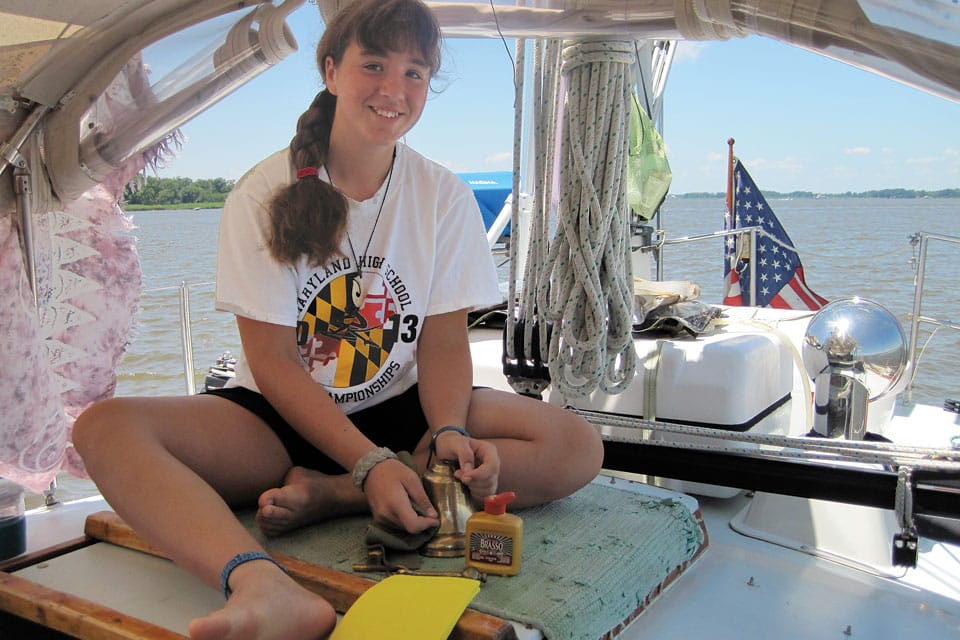
Over four years of cruising, as we put equipment to the test aboard Osprey , our Adams 45 steel cutter, we came up with a list of ideas and gear that fall under what’s known as the “pink jobs” category. Unlike the “blue jobs” list (see “ Simply Indispensable, ” January 2013), this is generally made up of simpler, mostly inexpensive systems or items that just plain work for everyday use. In their own small ways, they make the care and feeding of a family of four on board a little more efficient and easier.
Water Savings
1. Galley saltwater foot pump
This sounds old school, especially on many new boats that seem to want to make people feel like they’re living in a condo, not on a boat. But more than one fellow cruiser has envied ours. They resort to schlepping buckets of saltwater down to the galley to pre-rinse their dishes, or they lug the dishes to the transom to do the same. We just use the saltwater foot pump at the sink, then wash and final rinse with fresh water.
2. Freshwater foot pump (or hand pump) in the galley and head sinks.
This is the partner to number one, and I bring it up because so many boats I see use constant-pressure water in the head and galley. It doesn’t matter how frugal you are; pressure water systems invariably use more water than foot pumps.
Osprey came equipped with a freshwater foot pump for the galley and the head. In the head, hot water is pressure, but cold water (for daily stuff like tooth brushing) is via foot pump. In the galley, we added pressure hot and cold water but we rarely use it. It’s become so much a part of our routine to use the foot pump at either sink. If we want warm water for washing dishes or faces, we just heat it in a tea kettle and pour it in a bowl, rather than run the engine to make hot water and then turn on the pressure water pump to deliver it.
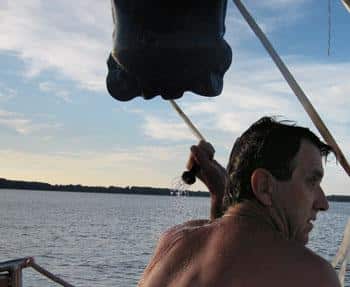
Even though I consider myself a low-maintenance female when it comes to personal buffing and fluffing, my one prerequisite is a hot shower. Daily. Osprey has a terrific shower, but whenever we are in climates and circumstances that permit it, we use the outdoor sun shower, which we hang from the aft arch. It accomplishes two things: One, it uses less water than a pressure-water shower; and two, the sun, rather than the boat’s engine, heats the water. So it’s a triple bonus, minimizing wear and tear on the boat’s hardware, saving fuel and helping conserve what is arguably the world’s most precious resource. We try to keep two on hand, since no matter the manufacturer, they only seem to last a season under heavy use.
In the Galley
4. Carbonated water makers
We don’t drink a lot of soda on Osprey , but we do mix carbonated water with fruit juices, and when you’re sick of Crystal Light and plain water there’s nothing so quenching as an ice-cold ginger ale or orange soda. Many of our cruising friends like the Sodastream system. It does take up counter space, and it’s a challenge to get replacement gas cartridges once you’re out of the country, so load up on them before you head out. We’d grown fond of the iSi Twist ‘n Sparkle, which is a smaller system, but the company has recalled its plastic bottles, citing a risk of bursting. The manufacturer is working on a redesign. For the record, nothing has exploded on Osprey . Either way you go, these eliminate a ton of can and/or bottle trash, and you don’t take up valuable storage space with flats of soda or spend stupid money to buy it in other countries.

Pressure cooker
This is the most basic piece of galley gear every serious cruising boat should have. They come in all sizes and models, ranging from the simplest jiggler to those with snazzy pressure-relief systems — whatever suits your fancy and comfort level. Osprey is equipped with an older-model Presto. From Presto online I ordered new gaskets and seals, and it works like a champ. Here’s how it makes life easier: You can cook complete one-pot meals hours in advance and they’ll stay warm and secure on the stovetop without having to reheat them. It’s a bonus when sailing in rough weather. You can make a nasty, tough cut of meat tender and tasty; you can cook the potential bacteria out of foods of questionable provenance. A recipe that requires several hours on the stovetop or in the oven can be cooked in a fraction of that time, saving on whatever cooking gas you’re using.

Recipes from Artisan Bread in Five Minutes a Day ** by Jeff Hertzberg and Zoë François
This book explains a method for quickly making excellent bread with no kneading that helped me keep a hungry family fed when we were sailing in remote areas that were short on just about every food staple but flour. You need enough space in your fridge for a plastic container of at least four quarts: I use a vertical rectangular container and there’s still plenty of room for everything else. This is where you toss the ingredients — flour, water, salt, yeast — mix, let rise once, and refrigerate for up to a week.
When you want a quick loaf of delicious, crusty bread, you pull out a hunk of the dough, shape it, let it rise 20 minutes, and then bake it in a hot oven for half an hour. The book recommends you use a pizza or bread stone; we bought one and cut it down to fit Osprey ‘s stove. But my friend Julie has also had success simply using a cast-iron frying pan that she pre-heats, and you can also just use standard bread pans.
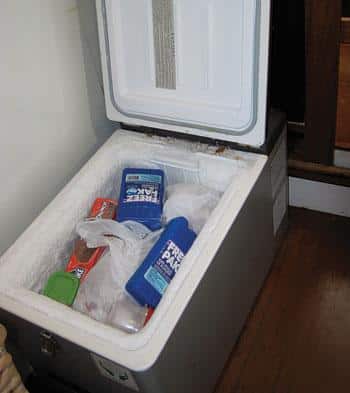
Stand-alone 12-volt freezer
Osprey has 12-volt cold-plate refrigeration, and if you lay something right against the plates eventually it’ll freeze. But it’s not a practical method, nor can you freeze a lot of stuff. We debated installing a full freezer but then had the good sense to learn from our friends, who raved about their Waeco 12-volt freezer. This cooler-size unit lived beneath their saloon table and easily froze meats, cheeses, ice and ice cream. We used a Waeco for the first three years and it performed admirably. In this last year we have switched to an Engel, which we like even more because it seems more efficient and sweats less than the Waeco did in humid climes.
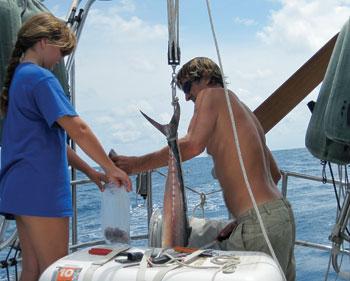
Food vacuum-bagging system
There are several brands; we bought a FoodSaver because Sam’s Club carried it and the proprietary bags in quantity. We use this versatile tool all the time. When we catch fresh fish that’s too big to eat in one or two meals, we can instantly vacuum bag and freeze it. Likewise, I can buy bulk quantities of meats, divide them into smaller portions and freeze them. Vacuum bagging eliminates freezer burn, and it also compresses the food so that you can fit more into the freezer. I also use it to seal and store coffee, flour, sugar, pasta and anything else that bugs can otherwise get into. Johnny has even used it to seal tools, spare watermaker filters and any other parts that he doesn’t want exposed to salt air.
9. Galley chamois and cloth napkins
Living in a house I routinely bought truck-size quantities of paper towels. On a boat, I lack the space, and in many countries paper products cost twice as much as they do in the U.S. Both reasons were incentive enough to try out Trader Joe’s Super Amazing Kitchen Cloths. These are like chamois cloths for the galley, and at $4 for a two-pack it’s hard to go wrong. They’ve completely eliminated the need for paper towels, with the exception of when we check the engine oil (we keep one roll for that). We use the cloths for cleaning all surfaces throughout the boat, inside and outside. When they’re dirty, we wash, dry and reuse. Saves on trash, saves on trees, saves on money. Likewise, we now use cloth napkins that we make from quilting scrap remnants you can buy cheaply at any fabric store, and you can use the same thing for wrapping paper.
10. Portable spin dryer and washer
These are on my wish list, because I haven’t figured out a place to store them on Osprey , but I have enough cruising friends who’ve had great success with them that I feel confident recommending them.
There are several brands; my friends swear by the Wonder Wash from the Laundry Alternative . It’s a little hand-cranked washing machine that uses only elbow grease and minimal fresh water. Then, switch to the Laundry Alternative Spin Dryer, which does use 110-volt AC, but spins your clothes nearly dry in a couple of minutes, so a half-hour on the lifelines does the rest. I could recoup the cost of these nifty machines in maybe six laundromat trips in a destination like the Bahamas. These tools are a lot more fun than hand-washing in a drywall bucket, believe me.
Communications
11. Yotreps
This wonderful service, provided by Pangolin, a New Zealand-based website, costs nothing and enables family and friends to follow your track anywhere in the world, as long as you have an SSB and Sailmail or Winlink to send position updates. By registering your boat and sending daily position reports, you provide weather and sea state information to other sailors, and those at home with an Internet connection simply click on your boat’s name to see where you are. A Google Earth map pinpoints your latest position with whatever pithy little report you wish to add (it limits you to 80 characters).
12. Powered Wi-Fi antenna with router
A powered Wi-Fi antenna that you run up a halyard can mean the difference between handling email and surfing the Web comfortably at anchor or dinghying ashore to spend hours in some dirt-floored hut sweating onto your keyboard. Likewise, an onboard router makes it seamlessly easy for more than one computer to access the Internet at once, thereby preventing nasty territory disputes among spouses and siblings. There are many options for these; on Osprey we use an all-weather Ubiquiti Bullet and POE (power over Ethernet, which powers the system), a multidirectional antenna and a standard Cisco router. The whole system costs about $200 and can reach out and touch Wi-Fi sources several miles away.
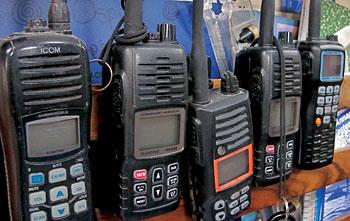
Handheld VHFs
These are the cellphones of the cruising family. Get a lot of them. It doesn’t really matter what brand. Especially when you have kids who spend a lot of time on the beach, running around and dropping stuff in the water; they’re vital for staying in touch and they take a beating. We used to have two; now we have four. Two for standard use, and two for backup. And we’ve had to use all four, at one time or another.
Osprey has landed for a while on the Chesapeake Bay and its crew is between voyages. This article first appeared as “Make it Easy” in the October 2013 issue of Cruising World .
Click here for more articles about living aboard.
- More: How To , liveaboard , Living Aboard
- More How To

Adding Onboard Electronics? Here’s How To Get Started
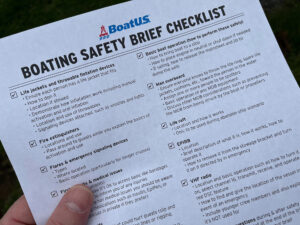
7 Boating Safety Tips for Summer Cruising
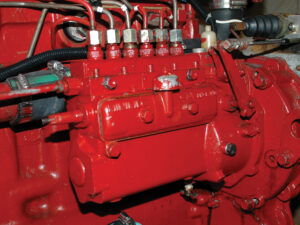
How to Prep for a Diesel You Can Depend On
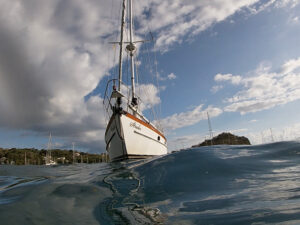
Anchoring in Paradise
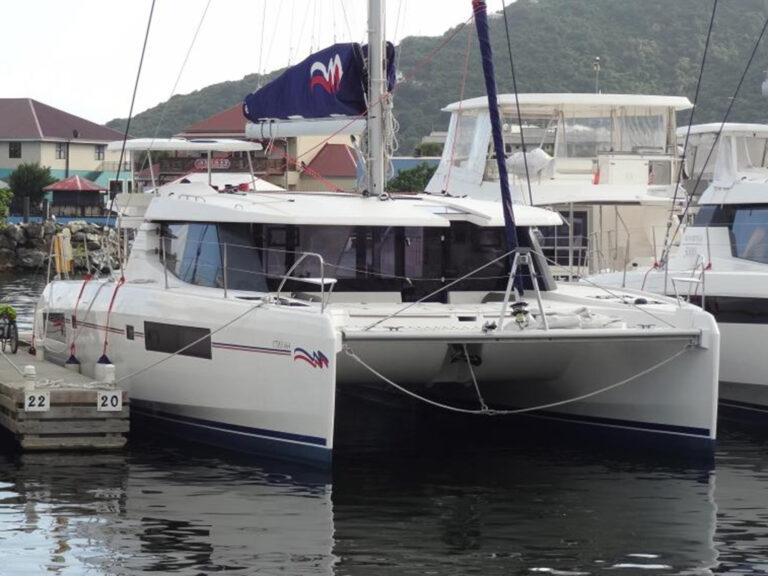
Now For Sale: Leopard 45

The Long Way Around

Sailing to the Land of Shrimp
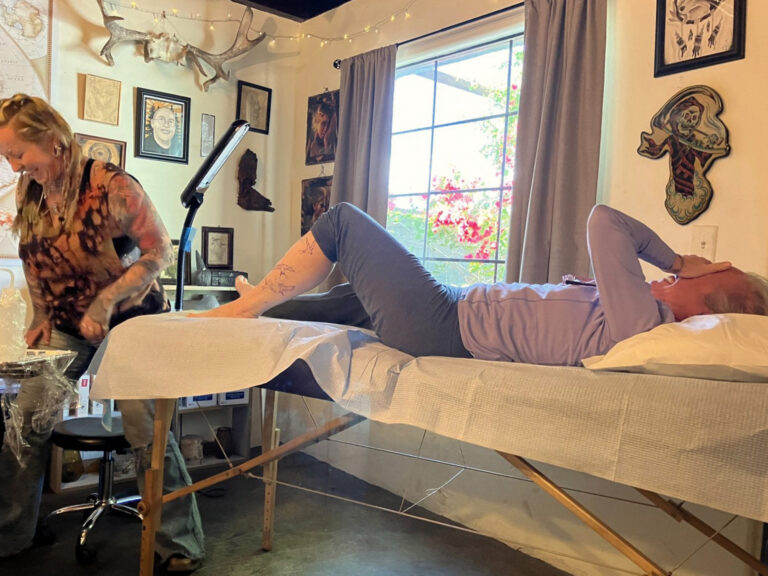
Swallow Tattoos and Sailors
- Digital Edition
- Customer Service
- Privacy Policy
- Email Newsletters
- Cruising World
- Sailing World
- Salt Water Sportsman
- Sport Fishing
- Wakeboarding

Beginner’s Guide: How to Live on a Sail Boat and Embrace the Ultimate Seafaring Lifestyle
Alex Morgan
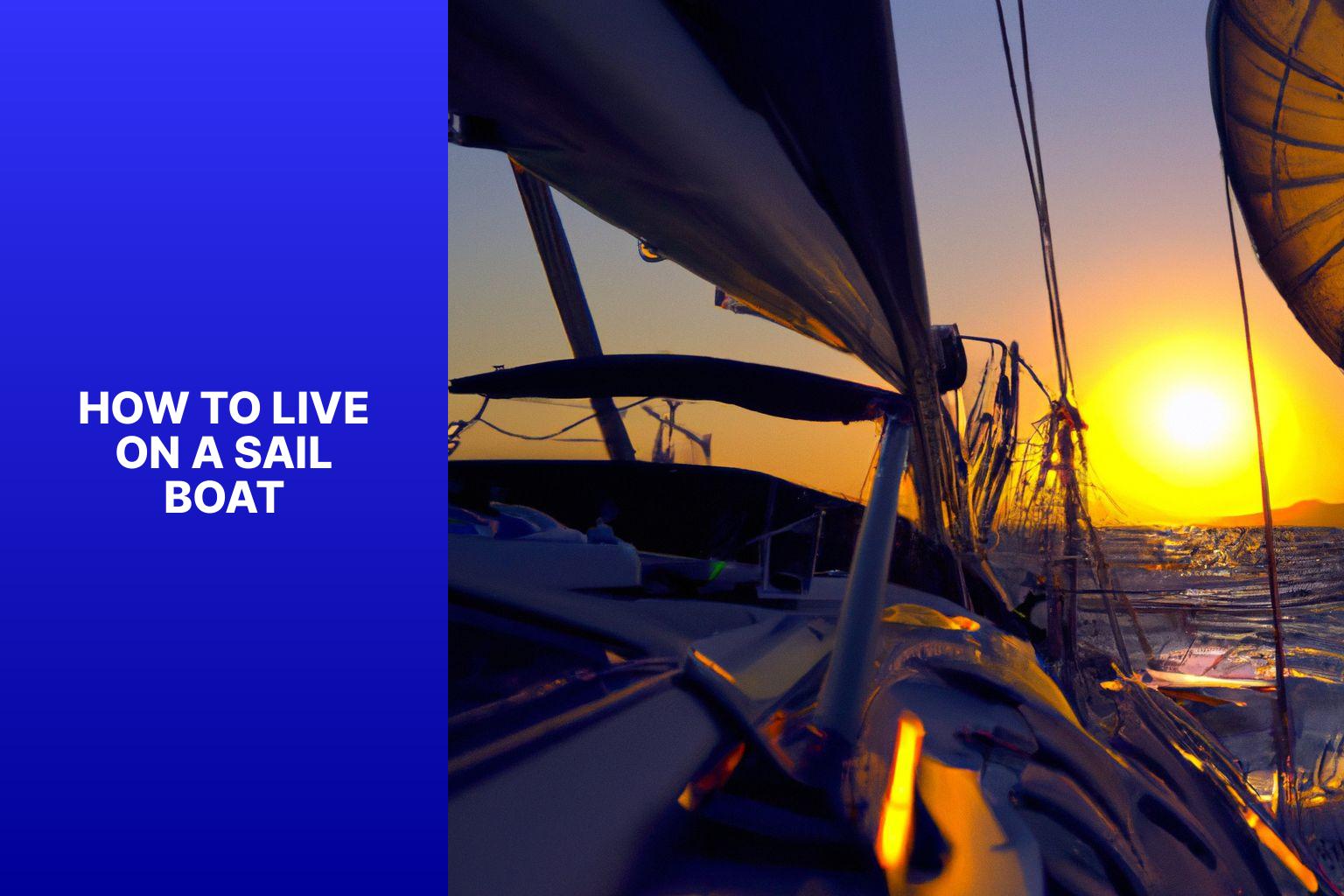
Living on a sailboat offers a unique and adventurous lifestyle that allows you to connect with nature and experience a sense of freedom and flexibility. It also comes with its own set of challenges and requires specific skills and preparation to ensure a safe and comfortable experience.
In this comprehensive guide, we will explore the ins and outs of living on a sailboat, from the benefits it offers to the practical considerations and essential skills needed. Whether you’re considering a permanent or temporary sailboat residence, this article will provide you with the information you need to make the most of this alternative lifestyle.
First, we’ll delve into an introduction to living on a sailboat, highlighting the allure and unique aspects of this lifestyle. We’ll then move on to discuss the benefits of living on a sailboat, including the freedom and flexibility it offers, the cost-effective nature of this lifestyle, and the opportunity to live in closer harmony with nature.
Next, we’ll delve into the preparation required before embarking on a sailboat living adventure. This includes choosing the right sailboat, ensuring safety and emergency preparedness, and acquiring the necessary sailing skills. We’ll provide tips and guidance to help you make informed decisions in each of these areas.
Once the preparatory phase is complete, we’ll explore the essential skills needed for living on a sailboat. This includes navigation and seamanship, weather forecasting and planning, as well as anchoring and docking techniques. These skills are crucial for ensuring a smooth and enjoyable sailboat living experience.
Moving on, we’ll cover practical considerations for living on a sailboat, such as managing limited space, basic maintenance and repairs, and staying connected with the outside world through internet and communication. These insights will help you navigate the unique challenges associated with living in a confined space and maintaining a comfortable living environment.
In addition to practical considerations, we’ll address the specific aspects of living comfortably on a sailboat. This includes managing power and energy, ensuring a steady supply of water and conservation practices, and handling cooking and food storage efficiently.
We’ll emphasize the importance of staying safe and healthy while living on a sailboat. We’ll cover topics such as first aid and medical preparedness, dealing with seasickness, and maintaining sun protection and proper hygiene.
By the end of this guide, you’ll have the knowledge and understanding needed to live on a sailboat confidently and enjoyably. So, let’s embark on this exciting journey and discover the wonders of sailboat living.
Key takeaway:
- Living on a sailboat offers freedom and flexibility: It allows individuals to have a nomadic lifestyle and explore different locations at their own pace.
- Living on a sailboat is a cost-effective lifestyle: Compared to traditional living arrangements, the expenses associated with living on a sailboat can be significantly lower. This includes reduced or eliminated housing costs and decreased energy consumption.
- Living on a sailboat brings you closer to nature: With the ability to anchor in remote locations and experience breathtaking landscapes and wildlife, living on a sailboat allows for a deep connection with the natural world.
Benefits of Living on a Sailboat
Living on a sailboat brings a world of incredible benefits. Imagine the freedom of exploring new horizons, the flexibility to chart your own course, and the sheer joy of being closer to nature. These are just some of the advantages that come with this unconventional lifestyle. Discover the untethered experiences and cost-effective living that await those who choose to call a sailboat their home. Get ready to embrace a life filled with adventure , simplicity , and a deep connection with the open waters.
Freedom and Flexibility
Living on a sailboat offers the ultimate freedom and flexibility. Here are the key benefits that come with this unique lifestyle:
1. Exploration: Living on a sailboat allows you to freely explore various destinations and coastal areas at your own pace. You have the freedom to change your location whenever you desire, embarking on new adventures whenever the mood strikes.
2. Flexible Schedule: One of the greatest advantages of living on a sailboat is the flexibility it offers. You can set your own itinerary, adjusting plans based on weather conditions and personal preferences. This means you can fully embrace spontaneity and have the freedom to make the most of every moment.
3. Adaptability: With a sailboat as your home, you have the incredible ability to adapt to changes in your environment. If you find a location that captures your heart, you can choose to stay longer, fully immersing yourself in the beauty and charm of your surroundings.
4. Financial Freedom: Living on a sailboat can also be a wise financial choice. By eliminating expenses like rent and utilities, you have the freedom to allocate your resources towards other priorities or unique experiences that bring you joy and fulfillment.
5. Connection with Nature: Imagine waking up to breathtaking sunrises, listening to the gentle sounds of waves, and being surrounded by the tranquil beauty of nature. Living on a sailboat allows you to have an intimate connection with the natural world, providing you with a sense of peace and harmony that is hard to find elsewhere.
6. Independence: Living on a sailboat fosters independence and self-reliance. As you navigate the waters, handle the boat, and manage limited resources, you develop a strong sense of confidence and sharpen your problem-solving skills. This newfound independence empowers you to embrace challenges and overcome obstacles with grace and resilience.
By embracing the freedom and flexibility that living on a sailboat offers, you can truly lead a fulfilling and enriching lifestyle. It allows you to fully embrace your adventurous spirit, appreciate the awe-inspiring beauty of nature, and live in a more flexible and cost-effective way.
Cost-Effective Lifestyle
Living on a sailboat offers a cost-effective lifestyle due to several factors. It significantly reduces living expenses. Unlike traditional housing, there are no mortgage or rent payments when living on a sailboat. Marina fees often cover utilities such as electricity and water. Sailors can also adopt alternative methods like solar power and rainwater collection to further cut down on costs.
Sailboats have minimal maintenance costs. While regular maintenance is necessary, the expenses associated with repairs are generally lower compared to maintaining a house or apartment. Sailors can learn basic maintenance skills and handle many tasks themselves, reducing the reliance on expensive professional services.
Owning a sailboat eliminates the need for a car in many cases, resulting in lower transportation expenses. Sailors can rely on their boat for transportation and freely explore various destinations without incurring additional travel costs.
Living on a sailboat also encourages a more minimalist lifestyle , promoting reduced consumption. With limited space onboard, sailors are compelled to carefully consider their possessions and only keep what is necessary. This approach helps trim spending on non-essential items.
Living on a sailboat fosters a closer connection with nature. It allows individuals to enjoy the beauty of nature and explore coastal areas. This lifestyle offers opportunities for engaging in free activities such as fishing , swimming , and beachcombing , as opposed to costly entertainment options.
Embracing a cost-effective lifestyle on a sailboat requires careful budgeting and prioritizing experiences over material possessions. By choosing to live on a sailboat, individuals can lead a more affordable, adventurous, and fulfilling life.
Closer to Nature
Living on a sailboat provides the advantage of being closer to nature. This proximity allows individuals to naturally appreciate the beauty of the natural world and immerse themselves in it. Here are some ways in which living on a sailboat brings you closer to nature:
1. Spectacular Scenery: Just imagine waking up to breathtaking sunrises over the open sea or witnessing stunning sunsets. Living on a sailboat means constantly being surrounded by majestic views and ever-changing landscapes.
2. Marine Wildlife: Being on the water offers the opportunity to observe marine wildlife up close. From dolphins and whales to sea turtles and colorful fish, you can witness the wonders of the ocean from your own floating home.
3. Sound of the Waves: The soothing sound of waves lapping against the hull creates a calming ambiance. The gentle rocking motion of the boat further enhances this serene experience, creating a deep sense of peace and tranquility.
4. Disconnecting from Technology: Living on a sailboat often means limited access to technology, enabling you to disconnect from the constant buzz of devices and fully immerse yourself in the present moment. This freedom from distractions allows for a deeper connection with nature.
I had the incredible experience of living on a sailboat for a few months. One morning, as I enjoyed my coffee on the deck, I was amazed to see a pod of dolphins gracefully swimming alongside the boat. I felt a sense of awe and gratitude for the opportunity to witness such a magnificent sight. It was a truly magical moment that reminded me of the beauty and harmony of nature. Living on a sailboat brought me closer to nature in ways I never thought possible, and those memories will forever be cherished.
Preparing to Live on a Sailboat
Preparing to live on a sailboat involves important considerations that will make your experience smooth and enjoyable. We’ll dive into various aspects of this adventure, including choosing the right sailboat that suits your needs, ensuring safety and emergency preparedness for peace of mind, and mastering the art of sailing . Buckle up as we navigate through the essentials of preparing for an incredible life on the open seas!
Choosing the Right Sailboat
When choosing the right sailboat, consider key factors:
- Size: Choose a sailboat size based on your needs and use. Smaller sailboats are easier to handle and larger sailboats offer more space and comfort.
- Design: Consider the sailboat’s design, including the hull shape, keel type, and rigging. Different designs suit various sailing conditions and purposes.
- Condition: Inspect the sailboat’s structural and mechanical condition. Look for damage or wear and ensure all components work properly.
- Sailing Performance: Evaluate the sailboat’s sailing capabilities, including speed, stability, and responsiveness. Assess the sailboat’s performance based on your skill level and sailing goals.
- Layout: Take into account the sailboat’s layout and interior space. Consider the number of cabins, galley and saloon size, and storage capacity to meet living requirements.
- Budget: Determine your sailboat purchase budget and consider maintenance, repair, and ongoing expenses like mooring fees and insurance costs.
By carefully considering these factors, you can choose the right sailboat that meets your needs and ensures a safe and enjoyable sailing experience.
Safety and Emergency Preparedness
Safety and emergency preparedness are crucial when living on a sailboat. It is essential to incorporate safety measures and be well-prepared for emergencies. Here are some key steps to ensure your safety on a sailboat:
1. Install safety equipment: Make sure to equip your sailboat with important safety equipment such as life jackets , fire extinguishers , a first aid kit , and emergency flares . These items are crucial in emergencies and can significantly increase your chances of survival.
2. Learn CPR and first aid : Having knowledge of CPR and basic first aid can be life-saving. Consider taking a course to learn these essential skills and be prepared to handle medical situations.
3. Develop a communication plan: It is vital to have a communication plan in place during emergencies. Ensure you have a reliable means of communication onboard, such as a marine radio or satellite phone . Familiarize yourself with emergency channels and protocols.
4. Maintain a float plan: Before setting sail, inform someone on land about your plans. Share details like your intended route, expected return time, and contact information. This way, authorities can be notified if you do not return as scheduled.
5. Practice emergency drills: Regularly conduct drills to prepare for various emergency scenarios. This includes practicing man overboard drills , fire drills , and emergency procedures like deploying a life raft .
Remember, prioritizing safety is paramount when living on a sailboat. By having the necessary safety equipment and knowledge, you can enjoy your sailing adventure while minimizing risks.
In April 2018, a sailing couple encountered a severe storm while crossing the Pacific Ocean. Despite facing damage to their sailboat from high winds and waves, their commitment to safety and emergency preparedness allowed them to navigate through the storm and stay safe. They attributed their successful survival to their training in emergency procedures and the presence of safety equipment onboard. This incident serves as a reminder of the importance of being well-prepared and equipped for emergencies while living on a sailboat.
Learning to Sail
Learning to sail is crucial for individuals living on a sailboat. Acquiring proficiency in sailing is necessary to ensure a safe and enjoyable experience on the water. It is important to consider the following key points when embarking on this journey:
1. Mastering basic sailing techniques: It is essential to grasp the skills necessary to properly trim sails, steer the boat, and control speed and direction. Learning these techniques will allow for effective navigation and maneuvering.
2. Prioritizing safety measures: Acquiring knowledge about wearing a life jacket, understanding right of way rules, and identifying potential hazards is paramount. Knowing how to handle emergencies such as a man overboard situation or sudden changes in weather is crucial.
3. Developing navigation skills: Gaining the ability to read charts, utilize navigation instruments, and plot a course with confidence is vital. Understanding buoyage systems and navigational markers will contribute to a successful sailing experience.
4. Being aware of weather conditions: Analyzing weather forecasts and comprehending the implications of different weather conditions is key in planning safe sailing trips. Interpreting wind patterns and anticipating weather changes will enhance overall preparedness.
5. Emphasizing practice and experience: Dedicate ample time to practice sailing on the water. Considering enrolling in sailing courses or joining sailing clubs can provide practical experience and valuable lessons from experienced sailors.
It is important to remember that learning to sail requires time and dedication. Both theoretical knowledge and hands-on experience are necessary components. By cultivating these skills, individuals will be well-prepared for their sailboat adventure.
Essential Skills for Living on a Sailboat
Mastering the art of living on a sailboat requires a set of essential skills. From navigation and seamanship to weather forecasting and planning, and finally anchoring and docking, each sub-section unlocks crucial knowledge for a smooth sailing experience. Discover the secrets of successful sailors and embark on a journey where precision , adaptability , and a deep understanding of the elements pave the way to a fulfilling life on the open seas.
Navigation and Seamanship
When it comes to navigation and seamanship on a sailboat, there are several essential skills and techniques to consider:
1. Understand charts and navigation tools: Familiarize yourself with nautical charts, compasses, and GPS systems to plot your course and determine your position.
2. Use navigational aids: Learn how to interpret and use navigational aids such as buoys, beacons, and lighthouses to navigate safely.
3. Maintain a proper lookout: Always keep a lookout for other vessels, obstacles, and navigational hazards to ensure safety.
4. Master sail trim: Learn how to adjust the sails to optimize performance and maneuverability in different wind conditions.
5. Understand wind and weather patterns: Analyze weather forecasts and recognize wind patterns to make informed decisions at sea.
6. Practice effective communication: Establish clear communication protocols with your crew to ensure safe navigation.
7. Navigate in different environments: Gain experience in various environments to adapt to different challenges and conditions.
8. Master basic boat handling: Develop proficiency in maneuvering your sailboat to safely navigate in tight spaces.
9. Understand collision regulations: Familiarize yourself with international rules of the road to prioritize safety.
By honing these navigation and seamanship skills, you can confidently navigate your sailboat for a safe and enjoyable experience on the water.
Weather Forecasting and Planning
Weather forecasting and planning are crucial skills for living on a sailboat. It is important to stay updated by regularly checking weather forecasts and updates to stay informed about current and upcoming conditions. This will help you plan your sailing trips .
To understand weather patterns , study different weather patterns and their impact on sailing . Learn about wind directions , tides , and currents in your area. This knowledge will aid navigation and decision-making at sea.
Use multiple sources such as meteorological websites , radio broadcasts , and weather apps to gather information and cross-check forecasts. Different sources may provide slightly varying predictions, so it’s important to have a comprehensive understanding .
Consider local knowledge and seek advice from experienced sailors familiar with the area you’ll be sailing in. They can offer valuable insights into local weather patterns and help anticipate potential challenges.
Prioritize safety when it comes to weather conditions. Avoid sailing in severe weather , storms , or strong winds that may endanger you or your vessel. Have a contingency plan in case weather conditions suddenly deteriorate while at sea.
To enhance your sailing experience , develop your ability to interpret weather data and make informed decisions. Take sailing courses or attend workshops on weather forecasting and planning to improve your expertise in this area.
Anchoring and Docking
Anchoring and docking are essential skills to acquire when living on a sailboat. Mastering these skills requires considering various factors for successful anchoring and docking:
1. Location: When choosing a spot for anchoring, it is important to find a suitable area that offers shelter from wind and waves. Look for a bottom that is sandy or muddy to ensure a secure hold.
2. Anchor Type: It is crucial to select the right anchor for your boat and the conditions you will face. Popular anchor types include plow anchors, Danforth anchors, and mushroom anchors.
3. Anchor Size: Ensure that you use an anchor that is appropriate in size for your boat’s length and weight. As a general guideline, the anchor should weigh 1 pound per foot of boat length.
4. Scope: The scope refers to the ratio of anchor rode length to water depth. For calm conditions, use a minimum scope of 7:1, but in rough weather, increase it to 10:1 or more.
5. Setting the Anchor: Drop the anchor, release enough rode, and slowly reverse the boat to firmly set the anchor in the seabed. Give it a strong tug to confirm that it is securely in place.
6. Docking: Practicing docking skills is essential to safely maneuver your boat into a slip or alongside a dock. Approach the dock slowly and use fenders to protect your boat from any potential damage.
7. Lines and Fenders: Before docking, make sure to prepare your lines and fenders to facilitate a smoother process. Properly secure the lines using cleats and knots.
8. Wind and Current: Consider the direction of wind and current when maneuvering your boat for docking. Utilize them to your advantage in order to control the movement of your boat.
Regular practice is key to mastering anchoring and docking. With time and experience, you will enhance your proficiency in these skills, ensuring a safe and enjoyable life on a sailboat.
Practical Considerations for Living on a Sailboat
Living on a sailboat requires a unique set of practical considerations that make this lifestyle both challenging and rewarding. In this section, we’ll dive into the nitty-gritty details of managing limited space, mastering basic maintenance and repairs, and staying connected while sailing the open waters. Get ready to sail into a world where every inch counts, where self-reliance is key, and where the constant motion of the waves becomes a way of life.
Managing Limited Space
Managing limited space is crucial on a sailboat. Here are steps to effectively manage limited space:
1. Organize: Keep belongings organized and declutter regularly. Use storage containers, shelves, and hanging organizers to maximize vertical space.
2. Choose multi-purpose items: Opt for furniture and equipment that can serve multiple purposes. For example, select a table that can also be used for storage.
3. Use space-saving storage solutions: Utilize under-bed storage compartments, collapsible boxes, and vacuum-sealed bags to make the most of limited storage space.
4. Embrace a minimalist lifestyle: Prioritize essential items and avoid unnecessary clutter.
5. Get creative with storage: Look for hidden compartments and use every available space. Consider wall-mounted hooks and nets for hanging and storing items.
6. Utilize vertical space: Install wall-mounted shelves and hooks to store items off the floor. Use hanging organizers for small items like toiletries and kitchen utensils.
7. Choose compact appliances and fixtures: Opt for smaller-sized appliances and fixtures designed for small spaces, such as compact stoves, mini fridges, and foldable furniture.
By following these steps, you can effectively manage limited space on a sailboat and create a comfortable living environment.
Basic Maintenance and Repairs
Basic maintenance and repairs are crucial for living on a sailboat. Here are some important tasks to consider:
- Clean and inspect the boat regularly to prevent mold, mildew, and corrosion.
- Check and clean the sails to ensure good condition.
- Inspect and maintain the rigging, including the mast, boom, and standing rigging.
- Check the hull and keel integrity for cracks or damage.
- Test and maintain the boat’s electrical system, including batteries and wiring.
- Clean and service the engine regularly for smooth operation.
- Inspect and maintain the plumbing system, including freshwater and waste systems.
- Perform routine maintenance on onboard equipment and systems, such as navigation instruments and safety equipment.
- Promptly repair any damage or leaks to prevent further issues.
- Keep a supply of spare parts and tools onboard for quick repairs.
Taking care of these basic maintenance and repairs tasks will keep your sailboat in good condition and always ready for your next water adventure.
Staying Connected
When living on a sailboat, staying connected is crucial for communication and accessing information. Here are some ways to ensure you can stay connected while sailing:
1. Mobile Internet: Get a reliable mobile internet plan or hotspot device for internet access onboard. This allows you to stay connected to email, social media, and browse the web.
2. Satellite Communication: Consider getting a satellite phone or satellite internet service for offshore communication. This ensures a connection even when you’re far from land or in remote areas.
3. VHF Radio: A VHF radio is essential for marine communication. It lets you communicate with other boats, marinas, and emergency services. Make sure you know how to use it properly.
4. Wi-Fi Boosters: Install a Wi-Fi booster antenna on your sailboat to amplify Wi-Fi signals from nearby marinas or hotspots. This can help you stay connected when you’re close to shore.
5. Weather Updates: Stay updated with weather forecasts for safe sailing. Use weather apps or listen to weather broadcasts on marine radios to plan your routes.
Staying connected is important for safety and convenience on a sailboat. By using the right tools and technology, you can maintain communication and access information wherever your sailing adventures take you.
Fun fact: Sailboats have been used for transportation and exploration for thousands of years. Ancient sailors used the wind’s power to navigate and explore the seas.
Living Comfortably on a Sailboat
Transitioning to a life at sea can be an exciting adventure, but how can you ensure a comfortable living on a sailboat? In this section, we’ll be exploring key aspects of living comfortably on a sailboat, including managing power and energy , water supply and conservation , as well as cooking and food storage . So, get ready to dive into practical tips and strategies that will enhance your sailboat living experience, making it a smooth journey all the way!
Managing Power and Energy
Managing power and energy on a sailboat is crucial for a comfortable and efficient living experience. Consider the following to effectively manage power and energy:
1. Invest in solar panels or wind generators to harness renewable energy and reduce reliance on fuel-powered generators. This sustainable approach promotes eco-friendly practices while ensuring a continuous power supply.
2. Utilize LED lights to minimize power consumption while providing bright illumination. LEDs are energy-efficient and contribute to a more sustainable power usage on board.
3. Opt for energy-efficient appliances , such as marine-specific refrigerators and fans. These appliances are designed to consume less power while still meeting your needs on the sailboat.
4. Implement smart battery management strategies by turning off lights and electronic devices when not in use. Consider utilizing a battery monitoring system to effectively keep track of battery usage and ensure a steady power supply.
5. Incorporate energy-saving techniques for heating and cooling , such as insulation and natural ventilation. These measures help minimize energy wastage and maintain a comfortable onboard environment.
To illustrate the effectiveness of these methods, let’s consider the experience of John , an experienced sailor. John installed a combination of solar panels and wind generators on his sailboat, allowing him to meet his energy needs sustainably. By also using LED lights and energy-efficient appliances, he successfully minimized power consumption. John implemented smart battery usage practices, which ensured a consistent power supply throughout his journey. With these measures in place, John was able to enjoy a comfortable and sustainable lifestyle on his sailboat, significantly reducing his environmental impact while embarking on his adventure.
Water Supply and Conservation
Living on a sailboat requires careful consideration of water supply and conservation. Water supply and conservation are crucial factors to keep in mind when living on a sailboat. Here are some important factors to consider in order to prioritize water supply and conservation:
1. Water storage: Sailboats have limited space, so it is important to plan for adequate water storage capacity. It is recommended to install additional water tanks or collapsible containers to maximize storage capacity.
2. Monitoring water usage: Being mindful of water consumption is essential. It is important to keep track of the water used for various activities such as dishes, personal hygiene, and others to avoid wastage.
3. Water filtration systems: Investing in a reliable water filtration system is highly recommended to ensure clean and safe water. Look for systems that can effectively remove impurities and harmful elements.
4. Rainwater harvesting: Utilizing rainwater is a great way to conserve water. Installing a collection system on the boat can help in collecting rainwater and using it for non-potable purposes like rinsing equipment or cleaning the deck.
5. Desalination: Installing a desalination system can provide a sustainable source of drinking and cooking water on longer journeys. This system can convert seawater into freshwater, ensuring a constant supply of water.
6. Conservation techniques: Implementing water conservation techniques is vital. Save water by taking quick showers, turning off faucets when not in use, and reusing water whenever possible. These simple practices can make a significant difference in conserving water.
7. Educating crew members: It is important to ensure that everyone on board understands the importance of water conservation and actively promotes responsible water usage. Educating crew members about the significance of water conservation can go a long way in achieving sustainable water supply.
By prioritizing water supply and conservation, sailors can maintain a steady and sustainable source of water while minimizing their environmental impact. Always remember, every drop counts!
Cooking and Food Storage
When living on a sailboat, cooking and food storage are essential considerations. Here are some important factors to keep in mind:
1. Storage Space:
Efficiently organize food storage on a sailboat using bins, baskets, and containers.
2. Non-Perishable Food:
Stock up on canned foods, dried fruits, nuts, and grains with longer shelf lives.
3. Meal Planning:
Plan meals in advance to avoid wastage and ensure you have enough provisions. Create a menu and shopping list to stay organized.
4. Galley Equipment:
Equip the sailboat’s kitchen with essential cooking tools such as pots, pans, cutlery, and utensils. Choose compact and multi-purpose items.
5. Fresh Produce:
Include fresh fruits and vegetables in your diet. Opt for produce that can be stored without refrigeration, like apples, potatoes, and onions.
6. Cooling Options:
Invest in a reliable cooler or refrigerator to keep perishable items fresh. Consider energy-efficient options or portable ice chests powered by solar panels.
By considering these factors, you can enjoy an efficient and enjoyable cooking and food storage experience while living on a sailboat.
Throughout history, sailors have mastered cooking and food storage to sustain themselves during voyages. They stock up on non-perishable items, utilize clever storage solutions, incorporate fresh produce, and invest in cooling options. By following these practices, you can enjoy delicious meals and ensure your food remains fresh and accessible during your sailboat adventure.
Staying Safe and Healthy on a Sailboat
Navigating the high seas and living on a sailboat is an exhilarating adventure, but it’s essential to prioritize your safety and well-being. In this section, we will explore some crucial aspects of staying safe and healthy on a sailboat. From first aid and medical preparedness to tackling seasickness and ensuring sun protection and hygiene, we’ll provide you with invaluable tips to keep you in top shape while exploring life on the water. So, get ready to set sail with confidence and peace of mind!
First Aid and Medical Preparedness
Living on a sailboat requires being prepared for medical emergencies. First aid and medical preparedness are vital for the well-being and safety of everyone on board.
- Knowledge and Training: Basic knowledge of first aid techniques and procedures is essential. This includes CPR, wound care, and handling common injuries on a sailboat.
- First Aid Kit: A well-stocked first aid kit is imperative. It should include bandages, antiseptic solution, adhesive tape, pain relievers, and necessary prescription medications.
- Emergency Communication: Reliable communication with onshore medical professionals is crucial. This could involve a satellite phone, a VHF radio, or access to a nearby marina’s communication system.
- Medical Evacuation Plan: Have a plan for medical emergencies that may require evacuation to a hospital or medical facility. Familiarize yourself with local emergency services and understand their response time and capabilities.
- Seasickness Prevention: Seasickness can be debilitating for some individuals. Have remedies on board and know how to prevent and manage this common condition.
By being prepared and equipped with necessary knowledge and supplies, you can handle any medical situation that may arise while living on a sailboat.
Dealing with Seasickness
– Stay hydrated: To deal with seasickness, stay hydrated. Drink enough water to prevent dehydration, as it can worsen symptoms.
– Choose your position wisely: Position yourself in the middle of the boat where the motion is least pronounced to minimize motion sickness.
– Focus on the horizon: Fix your gaze on a stable point in the distance, like the horizon, to reorient your senses and reduce seasickness.
– Get fresh air: Step outside onto the deck and breathe in fresh air. Being in an open area with good ventilation can alleviate seasickness.
– Acupressure: Apply pressure to specific points on your body, such as the wrist or inner forearm, to relieve seasickness symptoms. You can use acupressure bands or try massaging these points.
Fact: About 60% of individuals experience some level of seasickness when exposed to boat or ship motion. It is a common condition that can be managed with the right strategies and preparation.
Sun Protection and Hygiene
Living on a sailboat requires prioritizing sun protection and hygiene for a safe and comfortable experience.
- Wear sunscreen: Prioritize sun protection by using broad-spectrum sunscreen with a high SPF to safeguard your skin from harmful UV rays. Apply generously and reapply every few hours, especially on deck.
- Protective clothing: Ensure sun protection by wearing lightweight, long-sleeved shirts, pants, and hats to shield your skin from direct sun exposure. Look for clothing with built-in UV protection for added defense.
- Sunglasses: Invest in sunglasses that provide UV protection to safeguard your eyes from glare and prevent eye strain.
- Keep clean: Maintain good hygiene in close quarters by regularly washing your hands with soap and water to prevent the spread of bacteria and germs.
- Shower facilities: Check for onboard shower facilities. If unavailable, plan for regular visits to marinas or other facilities for your personal hygiene.
- Proper waste disposal: Follow responsible waste disposal practices to keep the environment clean. Use designated areas for waste disposal and opt for biodegradable toiletries when possible.
- Water conservation: Conserve water onboard by taking shorter showers and using water-saving techniques for dishes and laundry. This ensures an adequate freshwater supply.
- Stay hydrated: Prioritize sun protection by drinking plenty of water to prevent heat-related illnesses and stay hydrated in the sun.
Prioritizing sun protection and maintaining good hygiene practices enables a safe and healthy life on a sailboat.
Additional Resources
Here is a list of resources for living on a sailboat:
- Books: Highly recommended titles include “ The Essentials of Living Aboard a Boat ” by Mark Nicholas, “ The Cruising Life: A Commonsense Guide for the Would-Be Voyager ” by Jim Trefethen, and “ The Boat Galley Cookbook ” by Carolyn Shearlock and Jan Irons.
- Websites: SailNet , CruisersForum , and The Liveaboard Life provide resources, advice, and support for liveaboard sailors.
- YouTube Channels: Sailing La Vagabonde , Sailing Uma , and SV Delos offer entertainment, educational content, and real-life experiences related to living on a sailboat.
- Sailing Courses: The American Sailing Association and the Royal Yachting Association offer courses for all levels of sailors.
When I decided to live on a sailboat, I found a wealth of resources that provided guidance and support. Books, websites, and online communities gave valuable tips and insights from experienced sailors. Sailing courses helped me develop necessary skills. Now, I live my dream, sailing to new destinations and enjoying the freedom of living on a sailboat.
Some Facts About How To Live On A Sail Boat:
- ✅ Living on a sailboat can be a more affordable option for those who want to live on the water without paying coastal house prices. (Source: Atomictunayachts)
- ✅ It is important to avoid buying a fixer-upper boat as it can be costly and time-consuming to fix any problems. (Source: Atomictunayachts)
- ✅ Choosing a smaller boat can be beneficial as it is easier to handle, cheaper to buy, and can fit in more marinas. (Source: Atomictunayachts)
- ✅ Renting a slip in a marina is cheaper than coastal rent, but there can be a long waiting time for a slip in popular areas. (Source: Atomictunayachts)
- ✅ It is essential to have sailing experience and knowledge before moving onto a boat, including taking courses and being comfortable with the boat. (Source: Atomictunayachts)
Frequently Asked Questions
How can i reduce my living expenses by living on a sailboat.
Living on a sailboat can be a more affordable option compared to coastal house prices. It allows you to minimize your lifestyle, reduce monthly rent costs, and save on utilities by being mindful of water and electricity usage.
What should I consider when choosing a sailboat to live aboard?
When choosing a sailboat for liveaboard purposes, consider factors such as the size of the boat, its accommodations, and its condition. A smaller boat may be easier to handle and fit in more marinas. Buying a used sailboat in good condition can also help reduce costs.
What utilities do I need on a liveaboard sailboat?
On a liveaboard sailboat, you will need power, water, and sewage systems. Most liveaboards hook their sailboats up to shore power and water, while storing water and sewage in tanks. It’s also possible to install alternative energy sources like solar panels or wind turbines to reduce dependence on shore power.
How long is the waiting time for a slip in popular marinas?
The waiting time for a slip in popular marinas can vary, but it is not uncommon for there to be a long waiting time. It is recommended to inquire about slip availability and visit marinas in person to get a better understanding of the waiting times in your desired area.
What maintenance tasks are involved in living on a sailboat?
Living on a sailboat requires staying on top of maintenance tasks. This includes regularly checking for leaks and repairing them promptly, as well as conducting routine maintenance on safety equipment, electronic systems, and the overall condition of the boat. It’s important to be prepared for the ongoing maintenance involved.
Can I make money while living on a sailboat?
Yes, it’s possible to make money while living on a sailboat. Many liveaboards engage in remote work, freelancing, or even boat repair to support their lifestyle. Finding ways to work remotely or within the sailing community can provide financial stability while living aboard a sailboat.
About the author
Leave a Reply Cancel reply
Your email address will not be published. Required fields are marked *
Save my name, email, and website in this browser for the next time I comment.
Latest posts

The history of sailing – from ancient times to modern adventures
History of Sailing Sailing is a time-honored tradition that has evolved over millennia, from its humble beginnings as a means of transportation to a beloved modern-day recreational activity. The history of sailing is a fascinating journey that spans cultures and centuries, rich in innovation and adventure. In this article, we’ll explore the remarkable evolution of…

Sailing Solo: Adventures and Challenges of Single-Handed Sailing
Solo Sailing Sailing has always been a pursuit of freedom, adventure, and self-discovery. While sailing with a crew is a fantastic experience, there’s a unique allure to sailing solo – just you, the wind, and the open sea. Single-handed sailing, as it’s often called, is a journey of self-reliance, resilience, and the ultimate test of…

Sustainable Sailing: Eco-Friendly Practices on the boat
Eco Friendly Sailing Sailing is an exhilarating and timeless way to explore the beauty of the open water, but it’s important to remember that our oceans and environment need our protection. Sustainable sailing, which involves eco-friendly practices and mindful decision-making, allows sailors to enjoy their adventures while minimizing their impact on the environment. In this…
Save 40% off! Join our newsletter and get 40% off right away!
Sailboat Life
Sailboat Cruising and Lifestyle Magazine.

How to Live on a Sailboat for Beginners

This is a guide for how to live on a sailboat – but be warned, if you have any desire for the liveaboard lifestyle, you might quickly become on of us! Living aboard a sailboat requires an enjoyment of water, being okay with small living, and a sense of adventure. It’s not hard to begin living on a sailboat, but a few tips can help.
Let’s consider a few basic liveaboard questions first:
Is it living on a sailboat a good idea?
Living aboard a sailboat give you freedom that you won’t find in any other lifestyle. A suburban house can not be moved from place to place. But living on a sailboat gives you the options to live anywhere – literally in any country in the world! Living aboard a sailboat offers such a unique feeling of freedom to explore that you won’t find anywhere else.
Is living on a sailboat hard?
It is tough to live on a sailboat in a place like San Francisco where everyone is trying to escape super-high rent. In resort areas, many marinas have years-long waitlists for a liveaboard slip, and these slips cost double than a regular slip. However, not all places, in fact most places are easy to liveaboard.
Are you thinking about living aboard? Well, it takes time, planning, and preparation to being living on a sailboat. Here are a few videos to help you make a few calculations.
Adjusting to Liveaboard Life
Today, Emily sits down with 3 other female friends in the harbor to chat about how they transitioned from being landlubbers to liveaboard sailors in recent years. We’ll let you in on the conversation, and 4 different perspectives (though there are MANY others in the world).
- Emily, 34, aboard Temptress – liveaboard for 5 years
- Kris, 57, aboard Sixth Girl – liveaboard for 1 year
- Meredith, 44, aboard Tla Hla – liveaboard for 3 years
- Hannah, 26, aboard Sojourner – liveaboard for 2 years
How to Afford and Start Living Aboard
Your dream is to become a liveaboard? You want to know more about sailboat life, and what it means to live on a sailboat? You want to know how to afford living on a sailboat and how to afford staying liveaboards? How it feels to daily hoist the sail and follow the wind?
Start Small, Start Now
One philosophy in getting started living aboard a sailboat is to start small, start now. That doesn’t mean you have to buy a major refit project of a sailboat. You can get started in a small 24 foot single cabin boat for less than $10,000 or a mid-size 36 foot sailboat (see video below) for less than $60,000. Or grab a 1980s fixer upper that’s 42 feet in length that costs $25,000 – but beware, a fixer upper is a major expense even when you do it yourself.
Is Living Aboard for You?
No one can answer this question except you. However, if you enjoy freedom, have a sense of adventure, and love the water, then you might enjoy living aboard a sailboat.
We hope you enjoyed this how to guide for life on a sailboat for beginners. Leave us a comment or question a below.
Share this post!
Throw in your two cents, start a discussion cancel reply, related articles.

The Voyage of the Sea Star – 35ft Sloop to Bermuda

Living Aboard a 30-36ft Sailboat: A Guide for the Curious and Adventurous

Summer Sailboat Video, Bikinis, Sails, and Fun

Saved Up For This Dream

Sailboat Living: 10 Things To Know Before Moving On Board
Sailboat living can sound like the dream life, and in many ways it is.
Beautiful sunsets, the freedom to travel with your home, dolphins and crystal clear seas are all a huge part of the sailboat lifestyle , but anyone who tells you it’s an easy life has obviously never really lived on a sailboat!

There are times when sailboat living can feel more like a nightmare than a dream, and no matter how much you prepare there will always be a few troublesome scenarios that you just can’t predict.
However, with a little forethought and a lot of planning, there is a lot you can do to make the transition of moving from a house to a sailboat a relatively easy one.
If you’re prepared to put in the hard work now then we promise you will reap the rewards in the future. As we learnt the hard way, we’ve put together the top 10 things that everyone should know before they move onto a sailboat so that sailboat living for you can be 98% dream and only 2% nightmare!
As an Amazon Associate, we earn from qualifying purchases. We also earn from other affiliate programs. This means we may receive a small commission on products purchased through our links at no extra cost to you.
#1 A Sailboat Is Never Complete
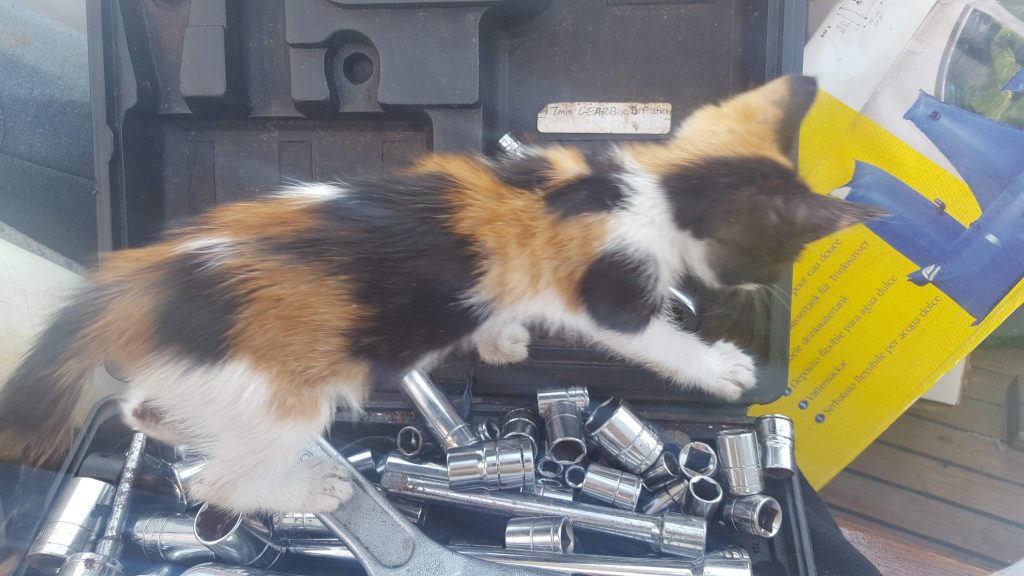
Learn this lesson fast!
Don’t expect to finish boatyard work and stop working. A sailboat breaks. Constantly. Some days it will feel as though your to-do list is endless because unfortunately, it is.
This was one of the things Adam and I were prepared for before we moved onboard our sailboat. After living on a boat in the UK we understood the crazy amount of work that has to go into maintaining something that’s constantly working.
I think a good way of looking at it would be to think of it as a house and a car combined. It has all the working parts of a house – the pipework, the electricity, the leaky windows etc.
It also has all the working parts of a car like an engine, the tires could be the sails, the lines, and all that goes along with them.
Add to that the fact that you’re putting it under huge amounts of stress at all times, in some extreme weather conditions, and you can see why things constantly fail!
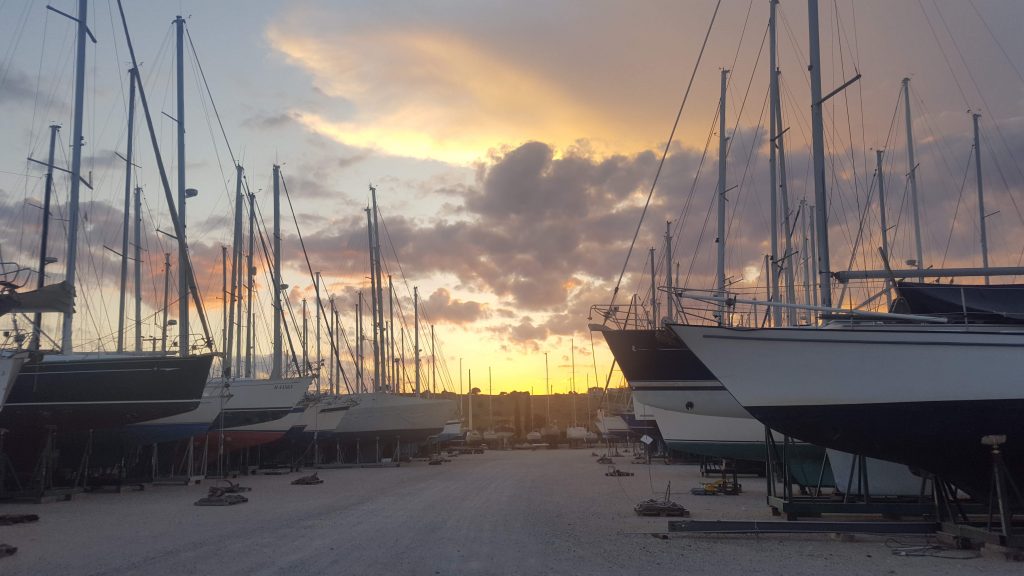
Adam and I spent the first few months of living aboard feeling as though we were just sailing from anchorage to anchorage to find chandlers so we could fix things. We made friends with some full-time cruisers who quickly put a stop to that!
They explained how if we actually wanted to enjoy time on board then we had to give ourselves time off the boat work. The broken things we could live with could wait a few days while we enjoyed a new destination.
Find out how much new sails cost
We now try to only do one or two days of boat work a week, which leaves us with a weekend ‘off’ when we’re working our jobs for three days. This suits us perfectly, but you’ll need to find a pattern that works for you to make sailboat living more enjoyable!
A bonus of living onboard is that you do have the extra time to dedicate to keeping the sailboat in tip-top condition.
Many weekend sailors find themselves with a long list of jobs at the end of the season, but (depending on how cheap/how lucky you get when you buy your boat!) if you get some jobs done every now and again through the season you’ll keep the long stints to a minimum.
#2 Sailboat Living = Tiny Space Living

Think of sailboat living as living in a glorified tent and you’ll be (partly) prepared! There is nothing glamorous about sailboat living!
You’ll be getting changed in tiny spaces where you may or may not be able to stand. You’ll be squeezing into the toilet or squeezing past people to use the kettle. It’s a juggling act, even when all your belongings are stashed away neatly.
Add to that the fact you’ll probably be ripping open cupboards every other day to find that essential item that was placed under all the other essential items and it becomes pretty hard to manage!
Our top tips for managing space onboard your sailboat are to downsize before you move in and to prioritise sailboat storage. It might be a hard thing to do to start with, but you’ll be so thankful you gave up all nonessential items before you even moved aboard.
It’s amazing how quickly you can fill a boat when you live on it! We have loads of handy tips on how to maximise limited space in our post on sailboat storage ideas – check it out before you start sailboat living!
#3 Water, Water, Everywhere But Not A Drop To Wash In

Get used to living frugally. We don’t necessarily mean your finances (though it is possible to live on a budget on a sailboat, check out what we spend monthly here).
Things like water and electricity are limited on a sailboat, especially if you’re spending the majority of your time at anchor.
Unless you have a sailboat watermaker (which we highly recommend splashing out on!) you need to get used to using as little water as possible . It’s not always easy to find when you live on the sea.
Get used to taking sea showers and washing dishes in saltwater. You can always rinse in freshwater, and washing in the sea really isn’t too hard once you’re used to it!
Set your sailboat up with a good way of making electricity as soon as you move aboard. You’ll want decent amounts of solar power and possibly a wind generator too, especially if you’re planning on spending time in countries that don’t see very much sunshine or spending winters at anchor.
You’ll also want to make sure you have a good battery bank for storing it over night, and you may even want to consider getting a small generator if you rely on power for things like charging laptops to work from.
#4 The People You Meet Will Be A True Highlight
The sailing community is what makes sailboat living. They are the most giving and generous community of people we have ever met and the best memories we have are the ones we spent with other cruisers.
It’s not always easy to meet other sailors while you’re living at anchor, so our advice is to make the effort and say hi where ever possible. People are always happy to share a drink or dinner, and a salty tale or two!
Meeting other sailors is also the very best way to learn more about sailing life. No matter how long people have cruised for they always have an experience worth sharing and learning from.
#5 The Weather Controls Your Life In Sailboat Living

We check the weather twice a day, every day. It may seem obvious that the weather is important on a sailboat, but until we moved aboard we didn’t realise quite how much it would affect our lives.
You might be desperate to move the boat and explore somewhere new but find you have no wind to sail. Or you might fall in love with an anchorage and want to stay but be forced to move because of a change in the direction of the wind.
We’ve had to leave beautiful anchorages in the middle of the night because an unpredicted storm had blown through, or been stuck in places we don’t like because the wind has meant it’s the only safe place to be.
The positives of being governed by the weather is that you’re so much more in tune with it. You get up when the sun rises, you notice subtle changes in the temperature and you learn to read the wind and clouds.

Before you move on board you should start checking the weather and anchorages around where you plan on sailing. It makes life easier if you’ve scouted out the best places to be in different weather conditions.
Check things like whether there are safe anchorages for different wind directions or whether you’ll need to use marinas (and how much they’ll be!), and check if there are any ‘bolt holes’ you can use as safe havens in the event of unexpected storms.
You’ll feel more confident and comfortable if you have all this information to hand when you start sailboat living.
#6 Sailboat Living Means Leaving Your Privacy On The Dockside
You’ll be sharing a tiny space with your crew and they will quickly learn literally everything there is to learn about you. And you them.
Before you move onto a sailboat make sure that you’re happy with sharing everything with the people you’re sailing with. I don’t mean you have to tell them about your childhood (though night passages can be pretty dull!) but be prepared to share what you eat, when you toilet, potentially what you throw up.
Expect to be walked in on while you’re changing or showering. Understand that boat toilets break – a lot – so no matter how careful you are you might well end up elbow deep in someone else’s last nights dinner!
#7 Learn To Work As A Team – Quickly

Sailboat living requires a huge amount of team work (unless you’re planning on living alone of course). You need get into a very different mindset when you live and work with the same person or people day in, day out, and when you depend on them (quite literally) to survive.
One of the biggest reasons that people quit at sailboat living is because they fall out with their partners, or call it a day before they do. Sailboat living is hard on relationships, but it can also make your relationship better and stronger if you’re prepared to work at it.
There are lots of things you can do to prepare for this change and I’ve put together a whole range of tips to help you with spending too much time with your partner .
Ultimately, one of the best things you can do is know that this isn’t going to be easy, no matter how strong your relationship is on land. Be prepared for this as a couple, and be prepared to work hard on your relationship when the tough patches come!
#8 Nature Is Incredible

I know, I know, we all know nature is incredible. But sailboat living brings you so much closer to it in so many different ways.
You see things you’d never get a chance to see on land. Every time you jump in the sea you find new sea creatures, either from snorkeling or finding them clinging on to your hull, or washed up on deck.
You see turtles, whales and rays. Birds come to find rest on your boat while you’re on long passages and dolphins swim beside you as you make waves for them to play in.

Then there’s the sunrises and sunsets, and the endless starlit skies. The thunderstorms that you’re suddenly a part of, when before you could hide inside brick walls. The constantly changing sea and sky, and the sun and wind. You become part of it, and you depend on it, and you’re terrified of it.
Sailboat living makes you feel like you’re part of the nature around you rather than just a lucky spectator. It’s certainly changed the way I see the ocean and the weather for the better and I have a new found respect and healthy fear of it’s power and awe.
#9 Prepare For Sleepless Nights

Before we set off cruising full time I had no idea how little sleep I would get. There are so many different things trying their hardest to ruin a good nights sleep on a sailboat.
Firstly, the weather. If it’s windy, you’ll be half awake all night just watching the anchor and wondering if this will be the night it pulls out and you drag into some rocks.
You’ll be waiting for the wind to shift slightly so that you’re no longer protected from the sea. And even if you’re super happy with your anchoring set up, the wind through the halyards makes a very disconcerting noise!
If the weather is calm that doesn’t mean the sea will be. You can never predict whether the anchorage you arrive in will be the rollyest place on the island, so you’ll spend a good few nights just rolling around all over the place trying your hardest to stay in your berth.

Then there’s the heat (or the cold, depending on where you sail). It can be unbearably hot inside a sailboat, so consider buying a decent hammock and sleep under the stars instead.
But if you decide to sleep outside you’re going to want a mosquito net, because those things are FIERCE. Never have I ever experienced so many sleepless nights due to a buzzing in my ears and painful bites all over my legs.
If you can find a comfortable set up with your hammock and mozzie net then sleeping outside on a sailboat is one of the most magical things ever. The stars are brighter than you could ever imagine, and there are shooting stars a plenty. The stillness of a calm night at anchor is one of the very best things about sailboat living.
If you’re sailing with a baby you can expect even less sleep – make sure you’re prepared for that!

#10 Sailboat Living Is More Difficult Than You Could Imagine (But Totally Worth It)

Difficult sounds bad, but that would be inaccurate when describing sailboat living. It’s the hardest thing I’ve ever done and the best. And part of what makes it the best is that it’s the hardest. Does that make sense?!
Sailboat living can feel like a constant battle at times. You have to trek for an hour to find the gas to light your oven to make a cup of tea in the morning. You then have to go back again because you forgot the tea bags. Things break and need fixing. You can’t sleep because of a storm. You can’t leave the boat for days because the winds up and you’re scared the anchor might pull out.

I think people run away to sea to find freedom, but like everything freedom can be defined in so many different ways.
Sailboat living takes away your freedom of easy access to food and water. It takes away your freedom to step out of your front door into relative safety. At times it even takes away your freedom to run and walk.
What it does give you is freedom from monotony. Freedom from daily routine. It gives you the freedom to travel where you want (if not when you want) and the freedom from material possessions.
It doesn’t matter what you wear on a boat, it doesn’t matter how flashy your boat is or how much you smell! At the end of the day, out on the sea, it’s just you surviving. And in a way, that’s the most free I’ve ever felt.

Similar Posts

The Beginning Of Our Adventure

Sailing Greece In October: Why You Should Go

What To Pack For A Sailing Trip

13 Best Small Catamarans For Cruising 2024

How To Tie A Sailboat To A Mooring Ball

How Dangerous Is Sailing? The Truth About Dangers At Sea
15 comments.
I’ll be moving on a sailboat with my girlfriend this (still very new) year and I discovered your blog via Pinterest. We’re also writing weekly blog posts about our journey. Your writing is excellent, and I’d like to follow you on your mailing list. But it seems your form does not work. Fix it maybe? 🙂
Ah that’s strange! I can see people are still signing up, will have a look into that! Thanks for letting me know. Thanks so much for reading along. Where’s your boat? I’m so excited for you – those first few weeks aboard are the best!
I can’t seem to sign up for more. The web page has an error on my Android. Bummer.
Can you please add my email address to your email distribution list?
Thanks, Steve
So glad to come across you guys, finding out as much as we can before we take that leap. We are a couple coming to the end of a army career. The last 2 years will be in Kenya Nanyuki. Posted in June. Then we plan to get the dream sailing boat and travel. I am doing all my home work trying to find out as much as I can before we do this. Looking forward to reading about you both and tasking in everything any thing that we will I’m sure be incredible useful. Thank you Sandy
Sorry for the late reply, I’ve only just noticed your lovely comment. I hope you’re getting further along with your dream – would love to hear about it! If you need more help we’ve put together a huge guidebook detailing everything we’ve learnt, from the very beginning of the journey through to buying the boat and eventually living aboard and making it all work. https://twogetlost.com/guidebook
That’s really nice post. I appreciate your skills. Thanks for sharing.
Thanks for reading!
Thanks for the honest truth in this article. Doing all the research possible before following our dreams and in your footsteps 🙌💕⛵⚓
Thanks so much for your kind comment and really pleased we could help! Keep us updated on your journey, you won’t look back!
Wow! I am on a boat reading this while my partner is away for the first time in months, and it made me feel less insane and like there are tools to help us live our dream of minimalist sailboat life.. Thank you so much for your wise words and good tools..
I’m so pleased it helped and excited for you starting this journey! You won’t regret it, and we’d love to hear more when you find the perfect boat and move aboard! If you need more help we’ve put together a huge guidebook detailing everything we’ve learnt, from the very beginning of the journey through to buying the boat and eventually living aboard and making it all work. https://twogetlost.com/guidebook
- Pingback: How To Downsize Your Wardrobe For Boatlife | Two Get Lost
Any suggested reading on preparing your land life (home, insurance, anythin really) for departure. Sell the home or rwnt, thinks like that. Want to start preparjng a year ahead and struggling to make a plan..any blogs ir reading suggestions would be appreciated!
Hello, thanks for reaching out. First off – congratulations! You’re obviously set on your plan to move aboard and it will be amazing (and lots of other things too!!) We actually cover all this in part one of our guidebook. We go through everything we had to consider before moving aboard, things like whether to sell or not to sell, what to do with all your things, even little considerations like what to tell family and friends. We’ve included tick lists for planning the change in lifestyle. You can find it here. https://twogetlost.com/guidebook Part 2 is for after you’ve bought the boat – getting the boat ready for living aboard and all the other things that come along with living at sea. I hope it helps and please do let us know how you get on – perhaps we’ll see you out here soon!
It’s helpful to understand that when living in a sailboat, the weather controls every aspect of our lives. Not long ago, my wife and I decided to invest in a sailboat because we love the sea and nature. We’d like to buy one this year, and maybe in the future, we’ll need to read carefully your advice about living in a vessel.
Leave a Reply Cancel reply
Your email address will not be published. Required fields are marked *

Sailing's Best Hack: Sailing On The Jib Alone

Last Updated by
Capt Chris German
June 15, 2022
Sailing on the jib alone may seem unethical but is a great way to head downwind, sans main, while at the same time making it easy to switch from sail to power.
Downwind sailing can bring with it, a host of trouble. From accidental jibing to broaching, there are a ton of things that can go wrong when sailing with a main on the downwind leg. Mix in with that the hassle of raising and lowering the main, particularly if you're single-handing, and that jib starts to look pretty good.
Usually equipped with a roller furler, a jib can be peeled out and put away with a quick yank of line. Reefing a jib is as simple as pulling out a small flake of sail or shrinking it down to virtually nothing.
Sailing on the jib alone can save time, energy and effort and if you’ve never tried it, you're missing one of sailing’s best little sailing hacks.
Table of contents
The main is a pain
The main sail is your power house. A boat gets most of its momentum from the main; but it is also a giant pain in the rear to put up, take down, put on the sail cover, jibe, and do a whole bunch of other things.
In heavy air, the main is a terror with possible accidental jibes and overpowering events like broaching. In light air, you have just as much chance of jibing while running, but get little benefit from the main with barely enough wind to fill it.
In either scenario, heavy or light air, who is going to steer the boat if you're single-handing and have to climb up to douse the main, wrap it in sail ties and cover it with a sail cover? Even with an auto helm, that's a lot of work and a long time away from the helm.
What if you just doused the main and used the jib? Better still, what if you never put up the main in the first place?
Unlike the main, there is no sail cover, no sail ties and you never have to worry about the accidental jibe with your jib. It sits up on the bow, can catch all kinds of wind on the downwind leg and is a breeze to douse when it’s on a roller furler.
Here’s a little scenario for you:
You’re sailing home and will come into the dock in the next half hour. You don't want to raise the main just to pull it down in 20 minutes to come into dock and you really don't want to wake your crew who have been up all night at the helm. You also don't want to start your motor because that too will wake your crew and she needs as much sleep as she can get cause she is driving home while you sleep in the back seat.
You know you will have plenty of time to fire up the motor when you get inside the breakwater, but for the last half hour while you are in open water with a great breeze at your stern. Why not take advantage of the wind by sailing? Roll out your jib.
You uncleat your roller furler line and give the starboard jib sheet a tug. The jib rolls out on your starboard side and fills with air before you even think to pull it all the way in and your boat pushes forward at 4 knots and you don't make a sound.
Twenty mins later, you spy the safe water mark of the harbor and realize that it's time to get ready to dock the boat. You preheat the motor and turn the key and smell of exhaust fills the cockpit as the boat rumbles to life.
Within a moment your bleary eyed crew stumbles on deck and says, “Thanks for letting me sleep.I needed that.” You nod and smile, knowing that she will be eyes wide open when you are sawing logs in the back seat on the way home.
While your crew readies the fenders and dock lines, you give the roller furling line a yank and the jib tightly rolls up and you motor the vessel into your slip. You just pulled off one the greatest sailing hacks there is.
That’s really how easy it can be sailing on the jib alone. No muss no fuss, no main, no pain, just smooth sailing on the jib alone. Is it unethical? Well maybe, but it's just too damn easy not to do it.
Can I do it on the upwind leg?
The short answer to that is no. The Jib is useless alone on the upwind leg because it needs a main to work due to slot effect.
In the article, Guide to Sail Trimming And Shape, we discuss slot effect saying, “With a jib it (also) needs to have a nice wing shape to it, but in that case it needs to be pulled in concert with the mainsail because it enhances the flow of wind on the backside of the main. This is all under the lift principle which is mostly what is happening when you are upwind sailing.”
On the upwind leg, the jib squeezes the wind on the backside of the main and that causes the main to get more power. If the jib has no main to squeeze the wind on to, it is out of balance and carries too much wind on its back side.
That causes the boat to turn away from the wind because it has no main on the back side of the sailboat to counteract the effort to point it towards the wind. Unfortunately, sailing upwind with the jib alone will only cause you to sail in circles.
Sailing with the jib alone doesn’t work on the upwind leg and makes it kind of unethical because there is no balance between sails when you have only the jib out. Sailing purests might scoff at you if all you ever sailed with was your jib, but in my book, any wind is good wind and if a boat works a boat works so why not do it? The pirates did and look where it got them?
The transition from sail to power
Now I am not saying that jib sailing is gonna be the next Olympic event and there is no way it will win any races. It is a cheap sort of way of harnessing the wind on the sly and is kind of a lazy way to sail, but it works.
It’s particularly nice on days when you're not entirely committed to sailing. For example, light wind days.
Another scenario:
Say your cruising along under power and see a tiny little ripple of wind on what is otherwise a mill pond kind of day. You're not sure if the wind will fill in, or if it's gonna be an iron gennie sort of afternoon. You're sick of listening to the motor and the fumes are blowing back into the cockpit and making you nauseous.
You peel out the jib and try it.
Initially the jib fills mostly and you think ok, lets secure the motor and breath a little easier. The motor quiets and the boat slows to a bare motion of 2 knots.
The sun beats down on the boat and it's getting hot and a silence falls over the boat as the jib flaps uselessly in the still air. You should have kept the motor on.
If you had raised the main, your boat would still not be moving at all and everyone would be hot from climbing all over the cabin top to raise it, and now you would have to ask them to lower it. Who wants to be that guy?
Instead, you pulled out the jib and now you can just as easily put it away. You refire the motor and head back to the dock for gin and tonics in yacht club air conditioning, a fine alternative to heat exhaustion and sunburn on a non-wind sort of day - and you’re the hero.
I hate to say it, but I am a lazy sailor and I love sailing with the jib alone. It has its merits and there are days when it's just too hard to put up the main. I wouldn’t recommend doing it every day, and never on the upwind leg, but if the opportunity presents itself, why not take advantage of one of sailing's best little hacks. Do good, have fun, sail far and thanks for reading.
Related Articles
Capt Chris German is a life long sailor and licensed captain who has taught thousands to sail over the last 20 years. In 2007, he founded a US Sailing-based community sailing school in Bridgeport, CT for inner city youth and families. When Hurricane Sandy forced him to abandon those efforts, he moved to North Carolina where he set out to share this love for broadcasting and sailing with a growing web-based television audience through The Charted Life Television Network.
by this author
How to Sail

Most Recent

What Does "Sailing By The Lee" Mean?
Daniel Wade
October 3, 2023

The Best Sailing Schools And Programs: Reviews & Ratings
September 26, 2023
Important Legal Info
Lifeofsailing.com is a participant in the Amazon Services LLC Associates Program, an affiliate advertising program designed to provide a means for sites to earn advertising fees by advertising and linking to Amazon. This site also participates in other affiliate programs and is compensated for referring traffic and business to these companies.
Similar Posts

How To Choose The Right Sailing Instructor
August 16, 2023

How To Sail From California To Tahiti
July 4, 2023

How To Tow A Skier Behind A Boat
May 24, 2023
Popular Posts

Best Liveaboard Catamaran Sailboats
December 28, 2023

Can a Novice Sail Around the World?
Elizabeth O'Malley

4 Best Electric Outboard Motors

How Long Did It Take The Vikings To Sail To England?

10 Best Sailboat Brands (And Why)
December 20, 2023

7 Best Places To Liveaboard A Sailboat
Get the best sailing content.
Top Rated Posts
Lifeofsailing.com is a participant in the Amazon Services LLC Associates Program, an affiliate advertising program designed to provide a means for sites to earn advertising fees by advertising and linking to Amazon. This site also participates in other affiliate programs and is compensated for referring traffic and business to these companies. (866) 342-SAIL
© 2024 Life of Sailing Email: [email protected] Address: 11816 Inwood Rd #3024 Dallas, TX 75244 Disclaimer Privacy Policy
13 Dirt-Cheap Liveaboard Sailboats (That Are Actually Good)

When it comes to selecting a dirt-cheap liveaboard sailboat, you don't have to compromise on quality. There are many classic models and a few hidden gems that provide comfort, space, and sailing capabilities at a very affordable price. In this article, you'll find a list of classic liveaboard sailboats, as well as a few original finds that can fit your budget.
Liveaboard sailboats that are cheap but actually good include Westsail 32, Alberg 30, Tayana 37, Catalina 30, Ericson 35, Albin Vega 27, Bristol 32, Morgan 323, Contessa 32, Pearson 365, Hunter 31, Cal 34, and Tartan 30. The prices of these boats range from $5,000 to $50,000 or more.
Living aboard a sailboat on a budget doesn't mean you have to settle for less. These affordable boats can still provide the comfort and performance you're looking for. We've included some models that you can find on Craigslist.
- These budget-friendly liveaboard sailboats offer a great combination of affordability, performance, and comfort, making them ideal choices for living the sailing dream.
- Some classic models that provide you with enough room to move around and store your belongings include the Alberg 30 and the Tayana 37.
- Classic models such as the Westsail 32, Alberg 30, Tayana 37, Catalina 30, Ericson 35, and Albin Vega 27 are known for their seaworthiness and versatility.
- The cheaper the boat, the more likely you'll need to invest in repairs and spare parts over the years. This is where some more obscure finds can surprise you, such as the Contessa 32 and the Cal 34, which offer easy maintenance and relatively cheap spare parts.
On this page:
13 cheapest liveaboard sailboats that are good, key features of a good liveaboard sailboat, classic liveaboard sailboat models, affordable liveaboard sailboats.
When looking for an affordable yet reliable liveaboard sailboat , there are several important features to consider. These can greatly affect your overall experience and satisfaction with your chosen boat.
Layout and space : On a liveaboard sailboat, space and layout are crucial. You'll want a boat that offers efficient use of space, a comfortable living area, a functional galley, and adequate storage. Generally, 25 to 35 feet in length is the ideal size range for a liveaboard.
Sailing performance : Even if you plan to live aboard primarily , sailing performance should still be a priority. Consider its ability to handle light winds, heavy winds, and everything in between. Your boat should be able to handle various sea conditions and be easily maneuvered. It should be versatile enough for various wind conditions and sea states.
Hull design : The hull design of your sailboat will affect its stability and performance in the water. Look for a design that offers a good balance between comfort, safety, and speed. A full-keel or modified full-keel design provides stability and tracking in rough seas, while a fin keel offers better maneuverability in tight spaces like harbors and marinas.
Maintenance and construction : Pay attention to the boat's construction materials and quality. Fiberglass and aluminum are popular choices due to their durability and low maintenance requirements. Wooden boats tend to be more affordable but may require more maintenance and care.
In this section, we will discuss some classic liveaboard sailboat models that are known for their affordability, functionality, and reliability. These boats have stood the test of time and are excellent choices, especially for novices.
Westsail 32 is known as "the cruiser that launched the cruising boom"
The Westsail 32 is a sturdy, reliable, and comfortable liveaboard option for those seeking a classic, bluewater cruising boat. Designed by William Crealock, it boasts heavy construction, a full keel, a roomy interior, and seaworthy capabilities. With many of these boats available on the market, you can find a Westsail 32 in good condition at affordable prices.
Alberg 30 is a classic full-keel cruiser known for its seaworthy design
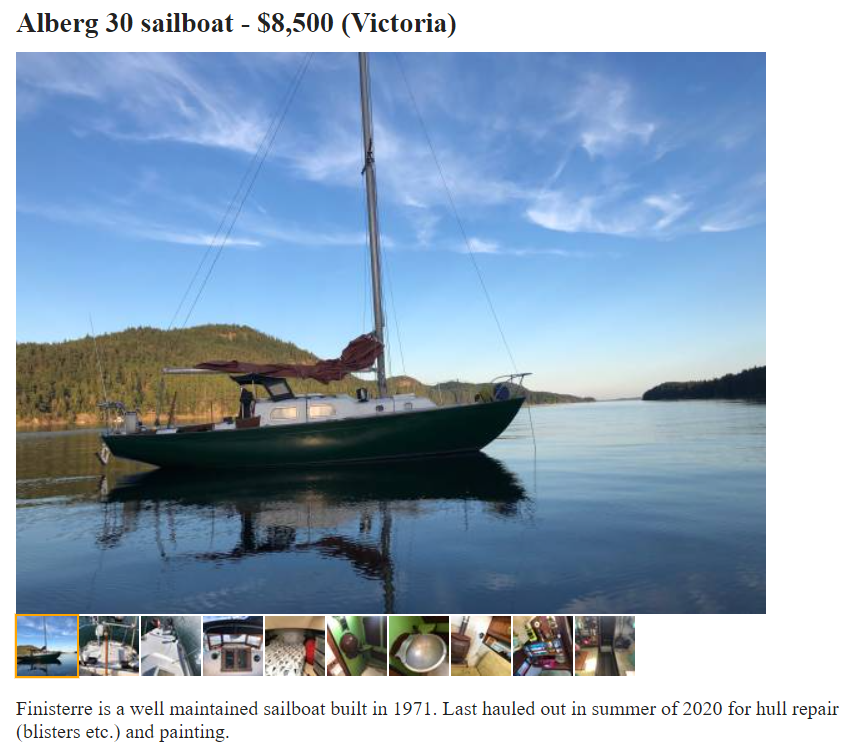
The Alberg 30 is a classic design from the 1960s, created by Carl Alberg, and built by Whitby Boat Works in Canada. This boat is known for being easy to sail and is a perfect choice for new liveaboards. The Alberg 30 has a simple layout, adequate living space, and enough storage to make it a suitable option for long-term living, all while keeping to a budget.
Tayana 37 is known for its seaworthiness and durability
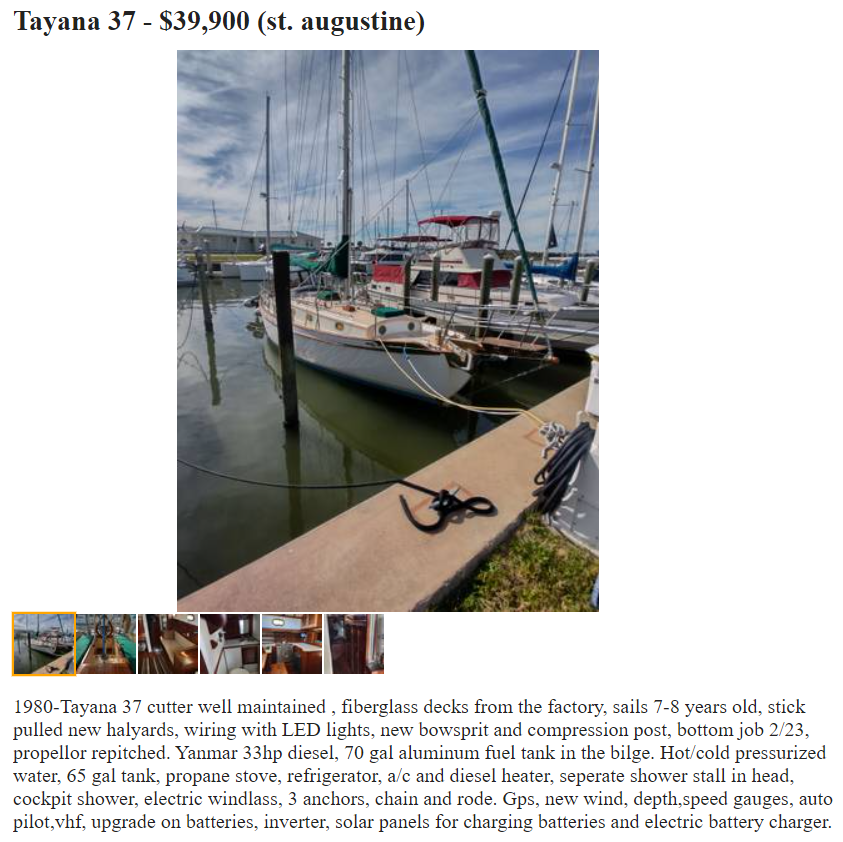
Designed by Robert Perry and built in Taiwan, the Tayana 37 is a popular and capable bluewater cruiser. This well-built classic boat is known for its comfort, safety, and ease of handling when sailing long distances. The Tayana 37 offers plenty of space and storage, making it a delightfully practical liveaboard choice, even for small families or couples.
Catalina 30 is one of the most popular sailboats of all time
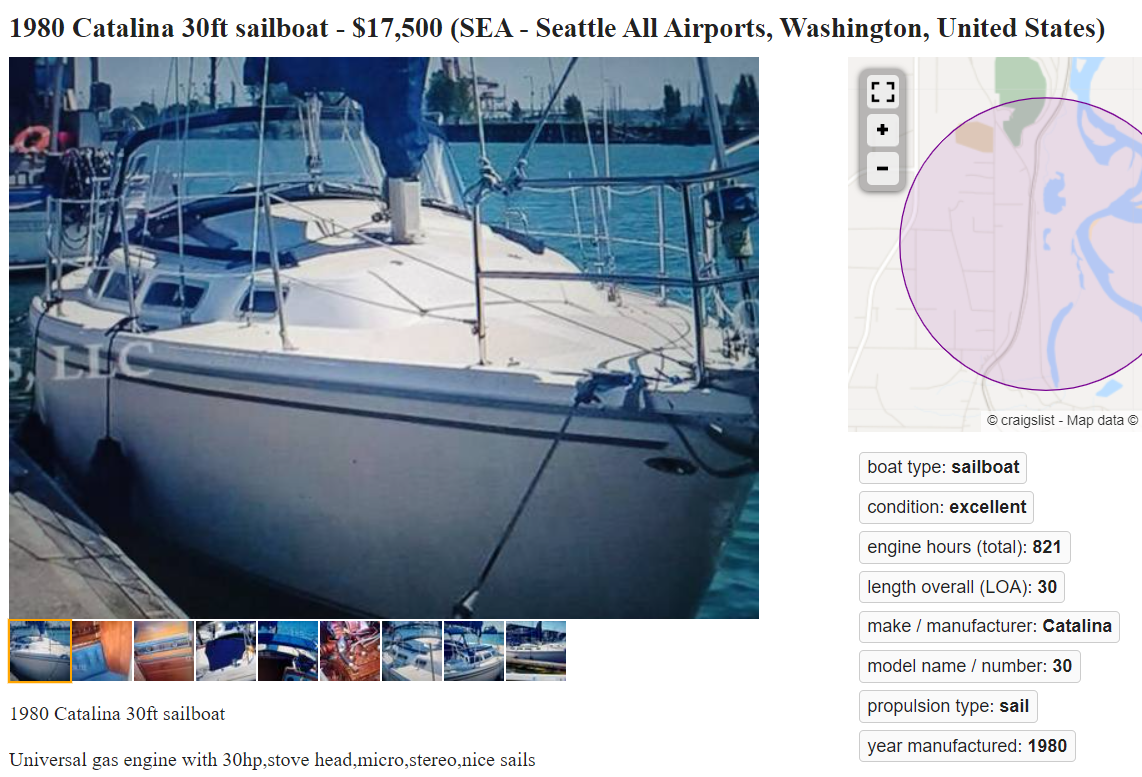
The Catalina 30 is one of the most popular sailboats in its size range and has a reputation for being an incredibly spacious boat, given its 30-foot length. Designed by Frank Butler, the Catalina 30 is known for its roomy interior and user-friendly layout, making it a fantastic option for liveaboard enthusiasts. The affordability and availability of the Catalina 30 also make it a top choice among sailors. It’s a tried-and-true option for liveaboard enthusiasts.
Ericson 35 has solid build quality
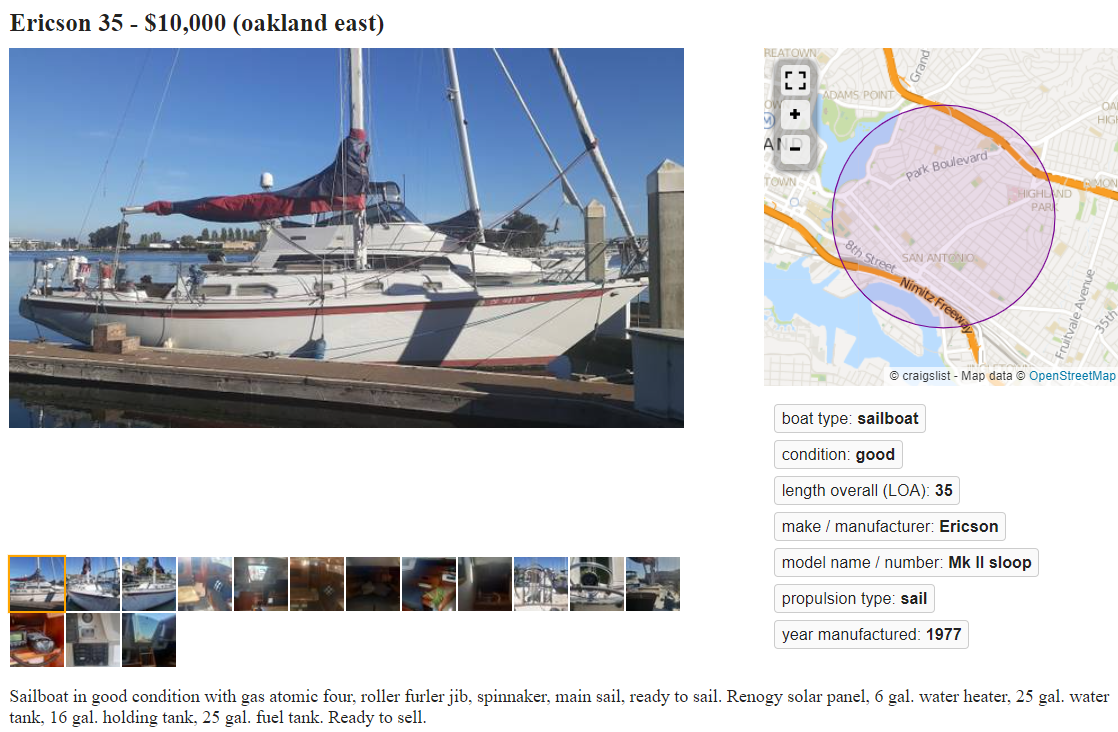
For those looking for a slightly larger liveaboard sailboat, the Ericson 35 is an excellent option. Designed by Bruce King and built by Ericson Yachts, it is praised for its solid build quality and comfortable accommodations. The practical layout and generous storage space make the boat a desirable choice for those looking to live aboard on a budget .
Albin Vega 27 is a proven ocean cruiser
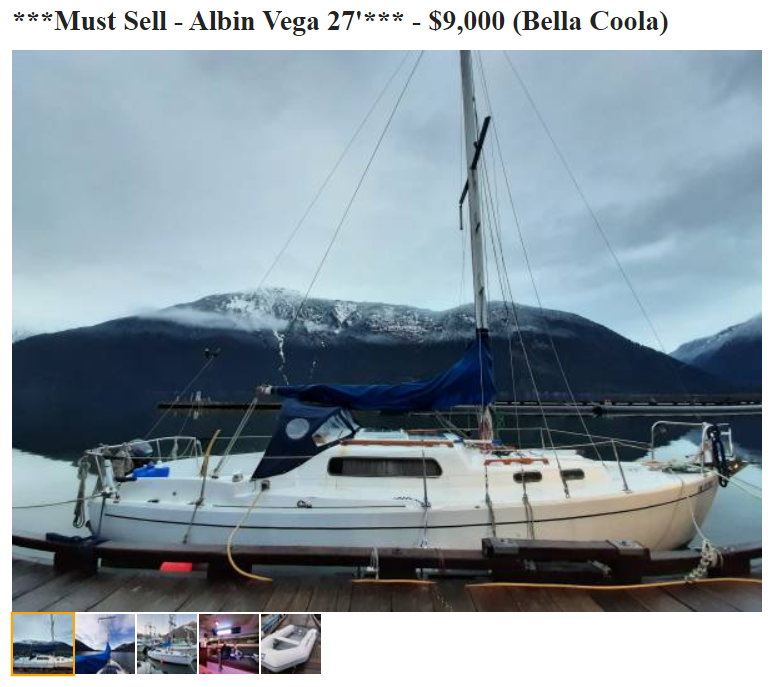
The Albin Vega 27 is a smaller liveaboard option for those who prioritize simplicity and affordability. Designed by Per Brohäll and built in Sweden, the Albin Vega 27 is a proven ocean cruiser with a surprising amount of space for a boat of its size. If you're looking for an affordable liveaboard sailboat with a compact yet functional layout, the Albin Vega 27 might be the perfect fit for you.
In your quest for a dirt-cheap liveaboard sailboat that's actually good, there are some finds worth considering. Let's dive into these affordable gems that were built for liveaboard life and sailing.
Bristol 32 is known for its classic design and solid construction
The Bristol 32 is a classic liveaboard sailboat with a solid reputation for its sturdy construction and excellent sailing performance. Designed by Ted Hood, this boat is known for its comfortable living spaces and adequate storage. A used Bristol 32 can be found at a reasonable price, making it perfect for those with a tight budget.
Morgan 323 provides stability and safety
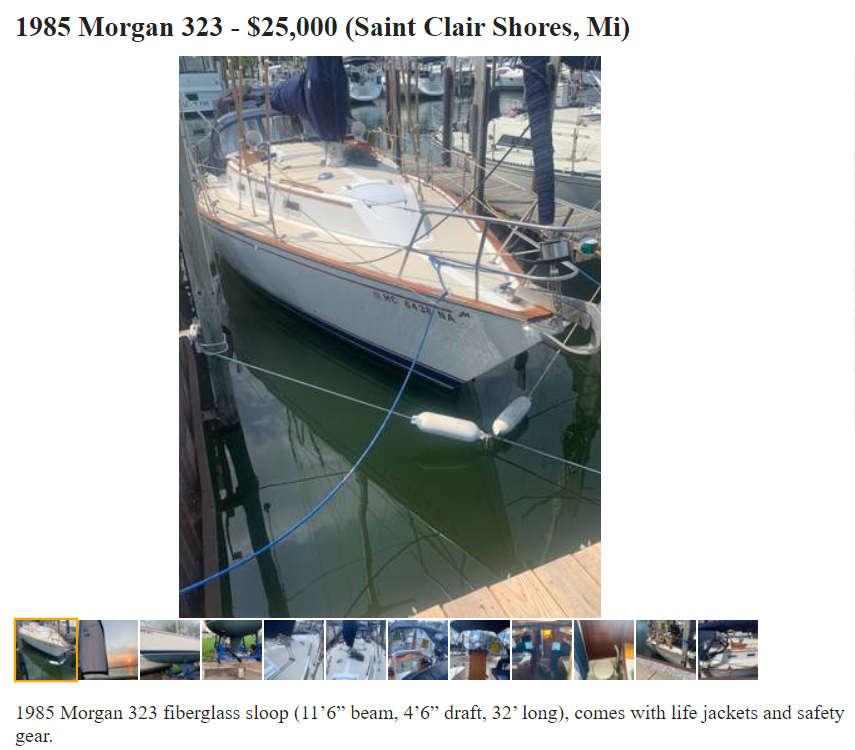
Next is the Morgan 323, which offers a great deal of interior space for a 32-foot sailboat. The well-designed layout ensures you have all the necessary amenities for living aboard while maintaining high sailing performance. Equipped with a full keel and skeg-hung rudder, the Morgan 323 provides stability and safety while underway.
Contessa 32 has a solid reputation for being safe, seaworthy, and comfortable
A British classic, the Contessa 32 is a small yet capable liveaboard sailboat , perfect for a couple or solo sailor. With its sleek lines, excellent performance, and well-built hull, the Contessa 32 is a go-to choice for many budget-conscious sailors. It's a rugged, seaworthy vessel that can handle various weather conditions with ease.
Pearson 365 is suitable for long-term and weekend cruises
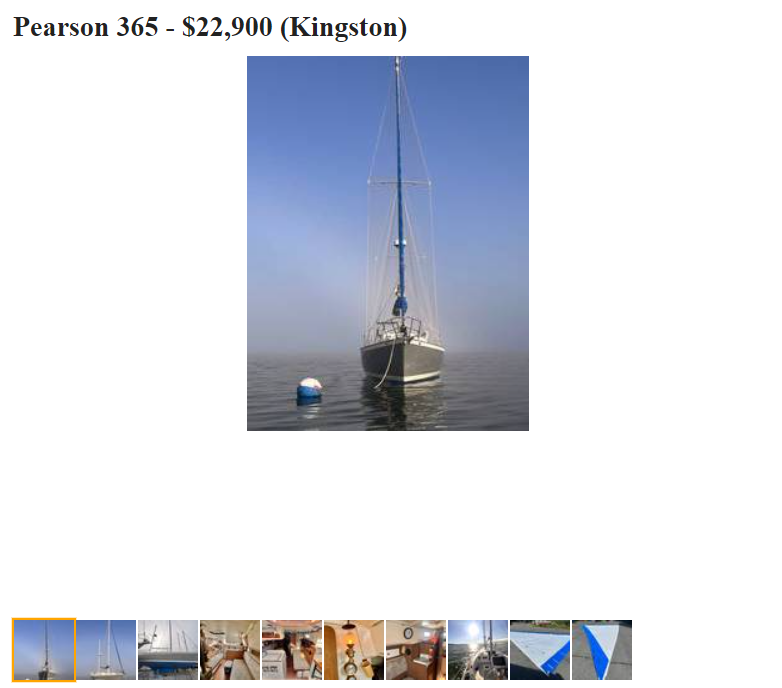
The Pearson 365 is another popular liveaboard sailboat, known for its spacious interior, comfortable accommodations, and reasonable price. With a roomy cockpit, plenty of storage, and a versatile sail plan, the Pearson 365 is well-suited for both long-term liveaboards and weekend cruisers.
Hunter 31 is well-rounded and spacious
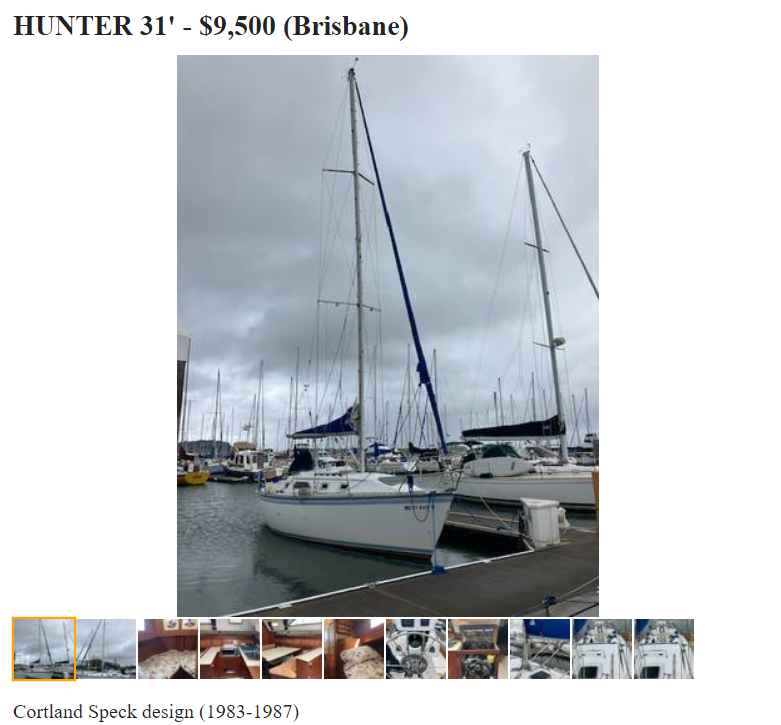
Affordable and easy to find, the Hunter 31 is a popular choice for budget-conscious sailors searching for a suitable liveaboard. With its beamy hull, the Hunter 31 boasts a spacious and functional interior. While not a traditional bluewater cruiser, the Hunter 31 can hold its own in coastal and nearshore environments.
Cal 34 offers solid sailing performance
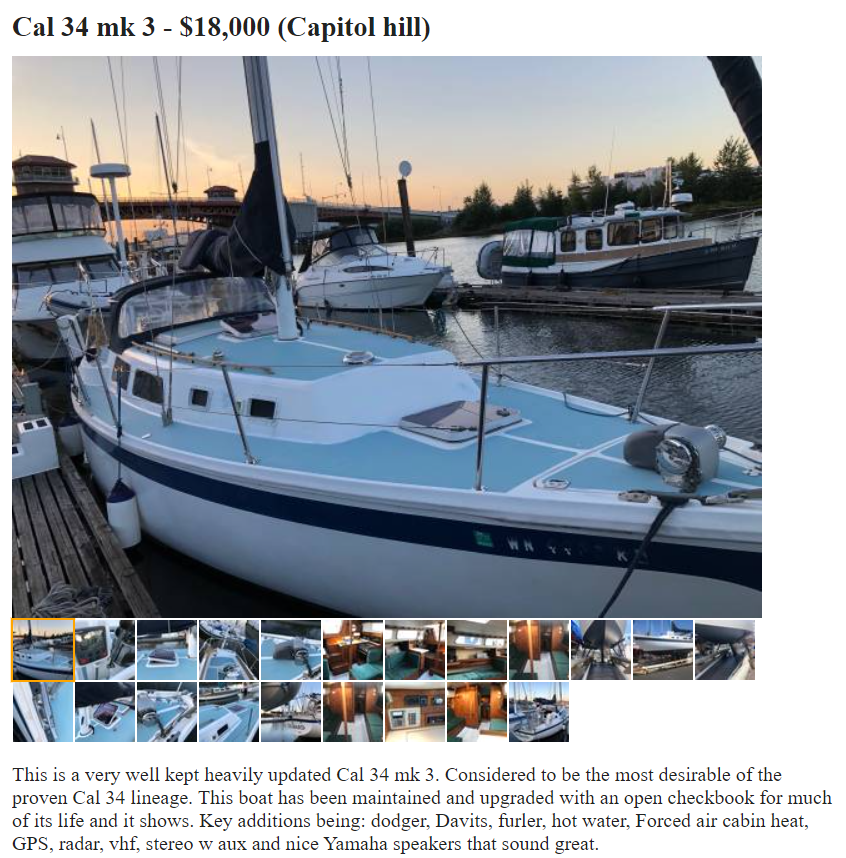
Another solid liveaboard option is the Cal 34. This well-designed sailboat has earned a reputation for its quality construction and comfortable living spaces. The Cal 34 strikes a suitable balance between performance and affordability, making it a popular choice among budget-conscious sailors.
Tartan 30 has enough space for living aboard
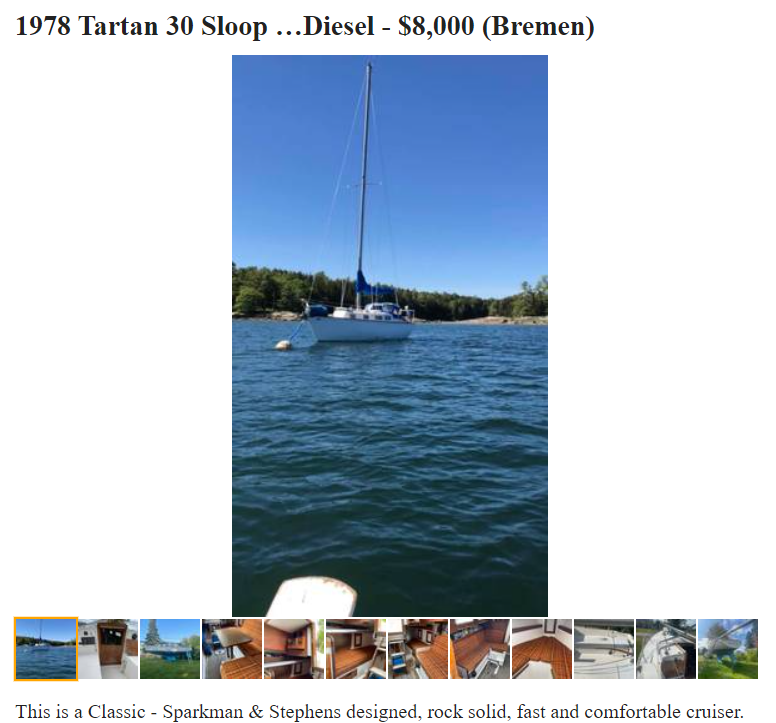
Last but not least is the Tartan 30. This sturdy sailboat is known for its seakeeping abilities and high-quality construction. The Tartan 30 provides adequate space for living aboard while maintaining its performance capabilities. Finding a used Tartan 30 at a great price is an excellent opportunity to secure an affordable, comfortable liveaboard.
Leave a comment
You may also like, sailboat vs. powerboat: what's the best liveaboard.
So you've chosen to live on a boat—the first step towards a pretty awesome dream. Now you gotta start figuring out the logistics. First of which is the choice of …

13 Most Practical Boat Liveaboard Places in the US

13 Best Liveaboard Sailboats (under 30 & 50 ft)

How To Self Isolate as a Liveaboard Sailor (7 Tips)

How To Live On a Boat For Free: How I'd Do It
Own your first boat within a year on any budget.
A sailboat doesn't have to be expensive if you know what you're doing. If you want to learn how to make your sailing dream reality within a year, leave your email and I'll send you free updates . I don't like spam - I will only send helpful content.
Ready to Own Your First Boat?
Just tell us the best email address to send your tips to:

6 Helpful Boat Storage Ideas & Easy Organization Hacks

As an Amazon Associate, we earn from qualifying purchases. We also earn from other affiliate websites. See our full disclaimer .
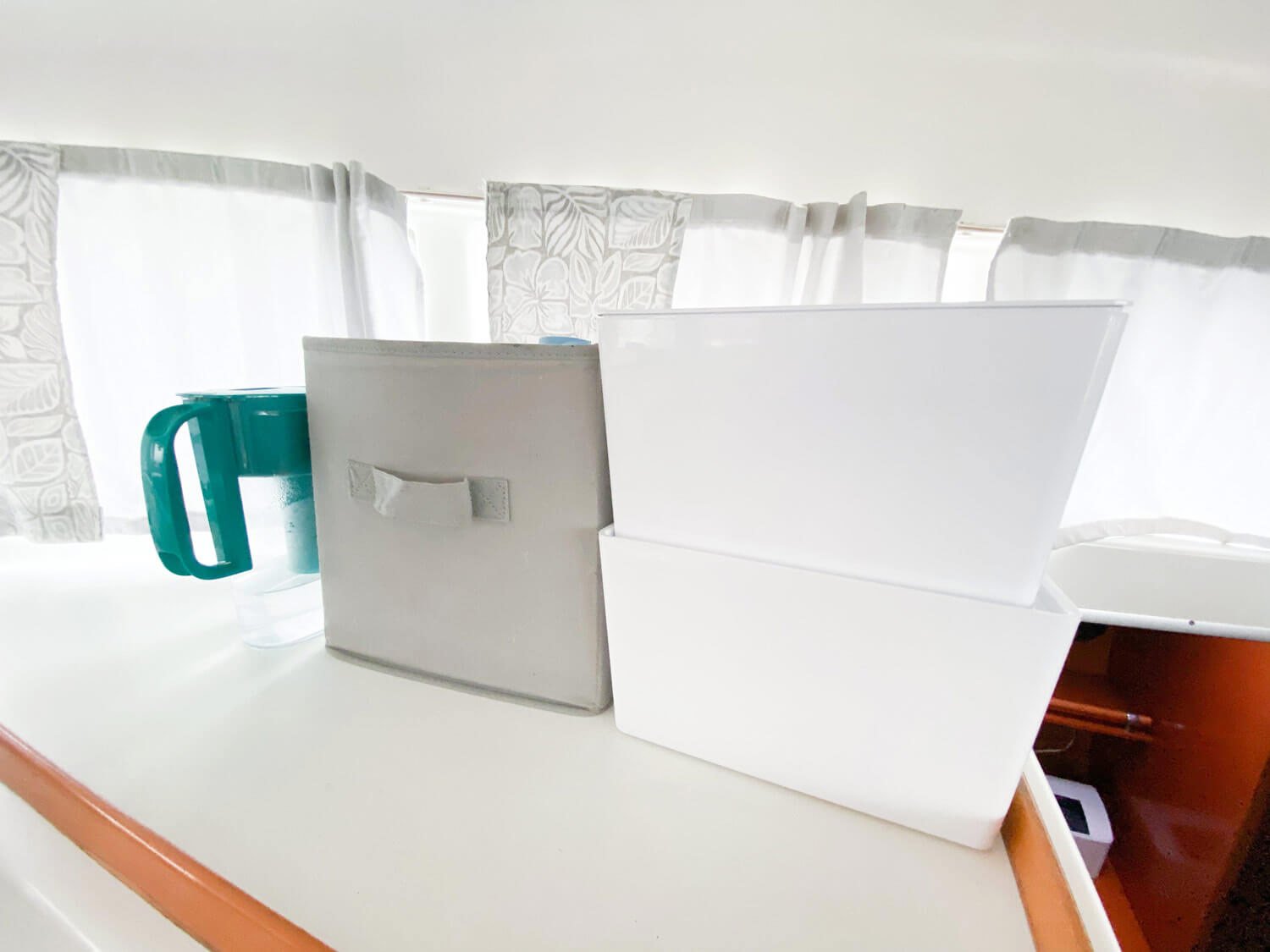
In any tiny living space, storage is one of the biggest challenges. It is even more unique on a boat due to the increased chance of mold and odd storage spaces.
What to keep in mind when storing things:
- How often you’ll need to access items
- Keeping items free of dirt, mold, and mildew
- Ease of storage so items will be more likely to get put away
Here are a few items, organization tips, and boat storage ideas that make living on the water more manageable.
1. Creating Easy Access Storage
A recurring challenge with storage on a boat is keeping items within easy access. Sure, there’s a ton of storage under the bed or down in a crash locker. But what about the things we use every day? How do we get to the things we need daily while keeping the boat from looking cluttered?
I saw these storage bins on The Wynns YouTube channel and knew I had to hunt them down.
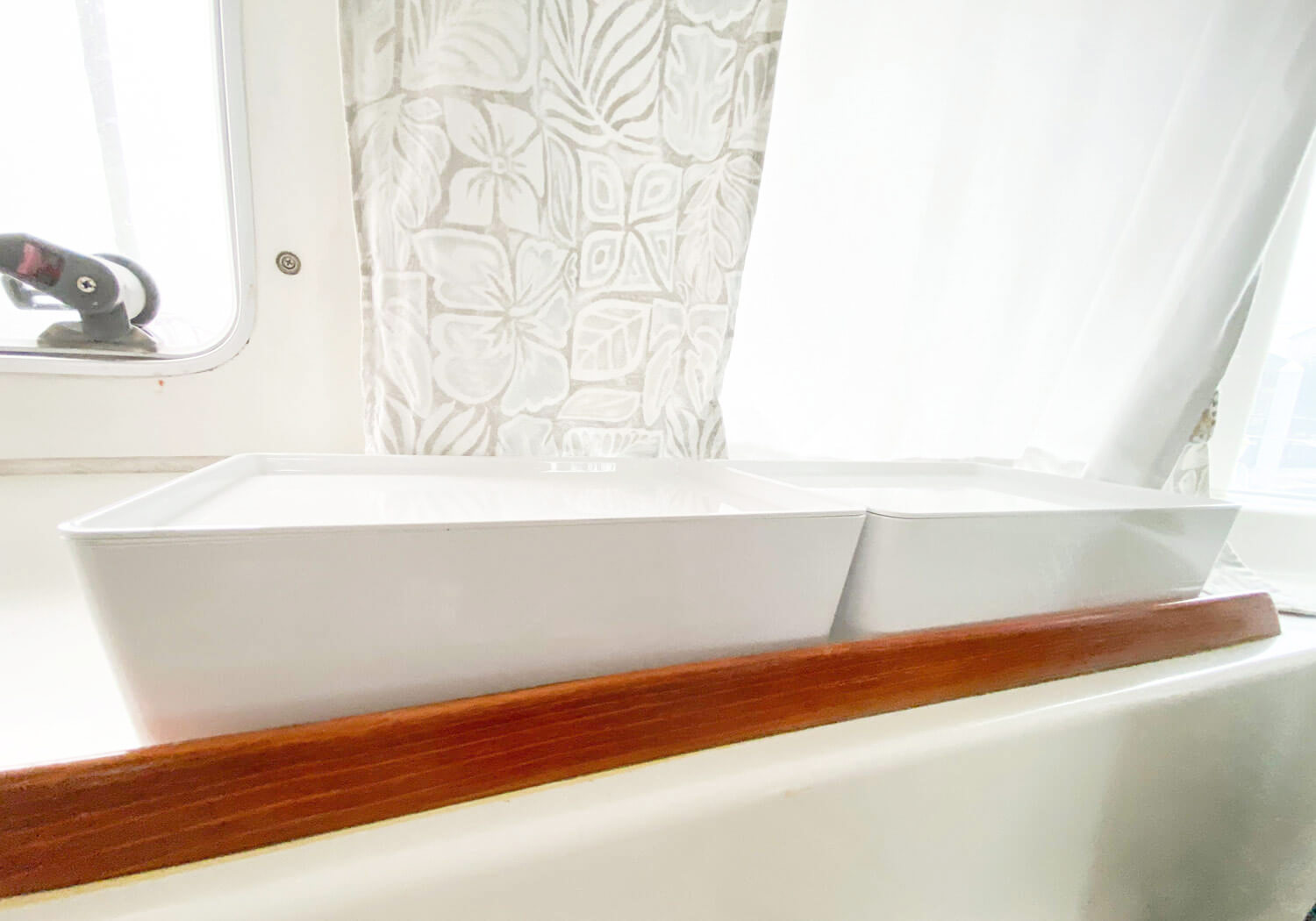
- Stackable storage boxes with lid
- Available in various sizes
- Available in white, turquoise, or transparent black
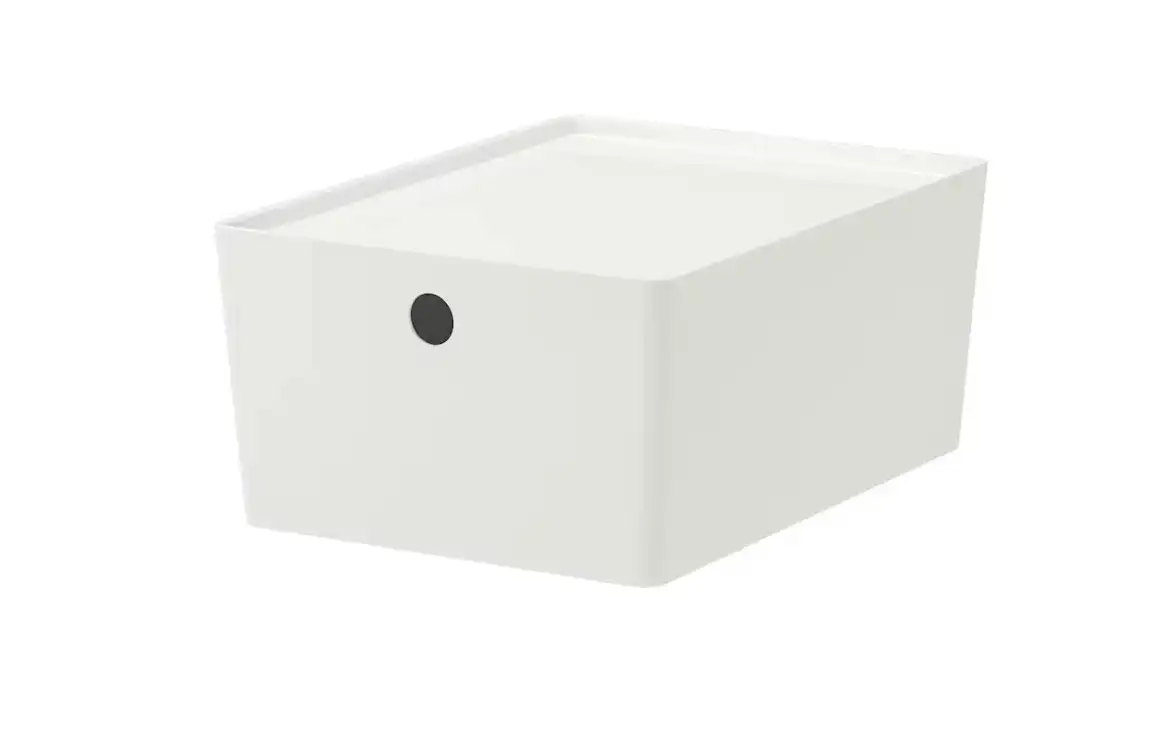
Storage Box Features
High-sided storage containers also keep the boat feeling less cluttered.
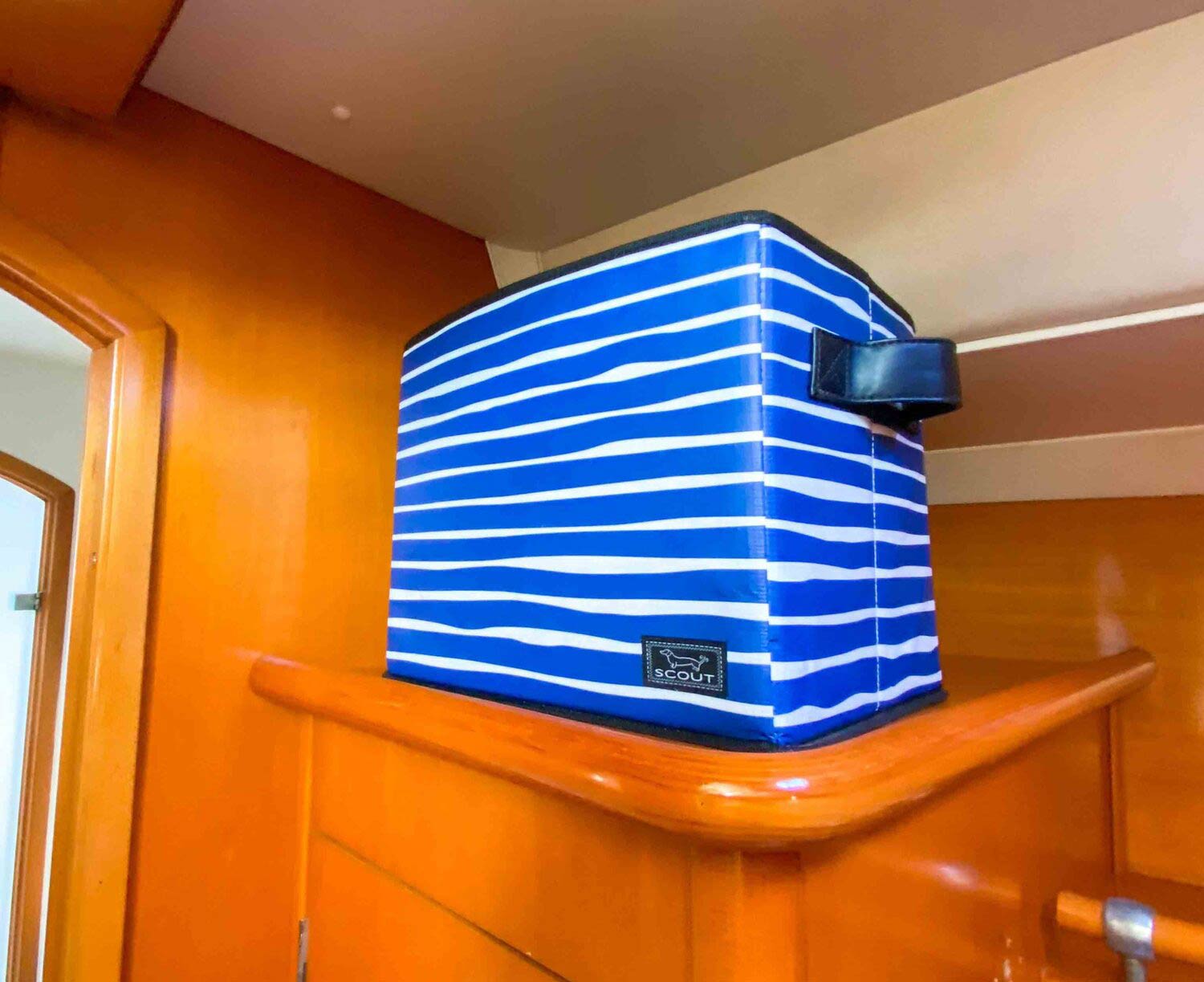
These Scout brand bins are water-resistant for easy cleaning. They also have handles to grab them from a shelf when you need to look for something.
ALTERNATIVE: The Scout brand is a bit pricey. For a more affordable option, try foldable fabric bins from Walmart or Target. Just make sure to spray them with a mold-prevention spray every couple of months.
Recessed storage area.
Anywhere you can secure items in a recessed wall or window area is an opportunity for storage.
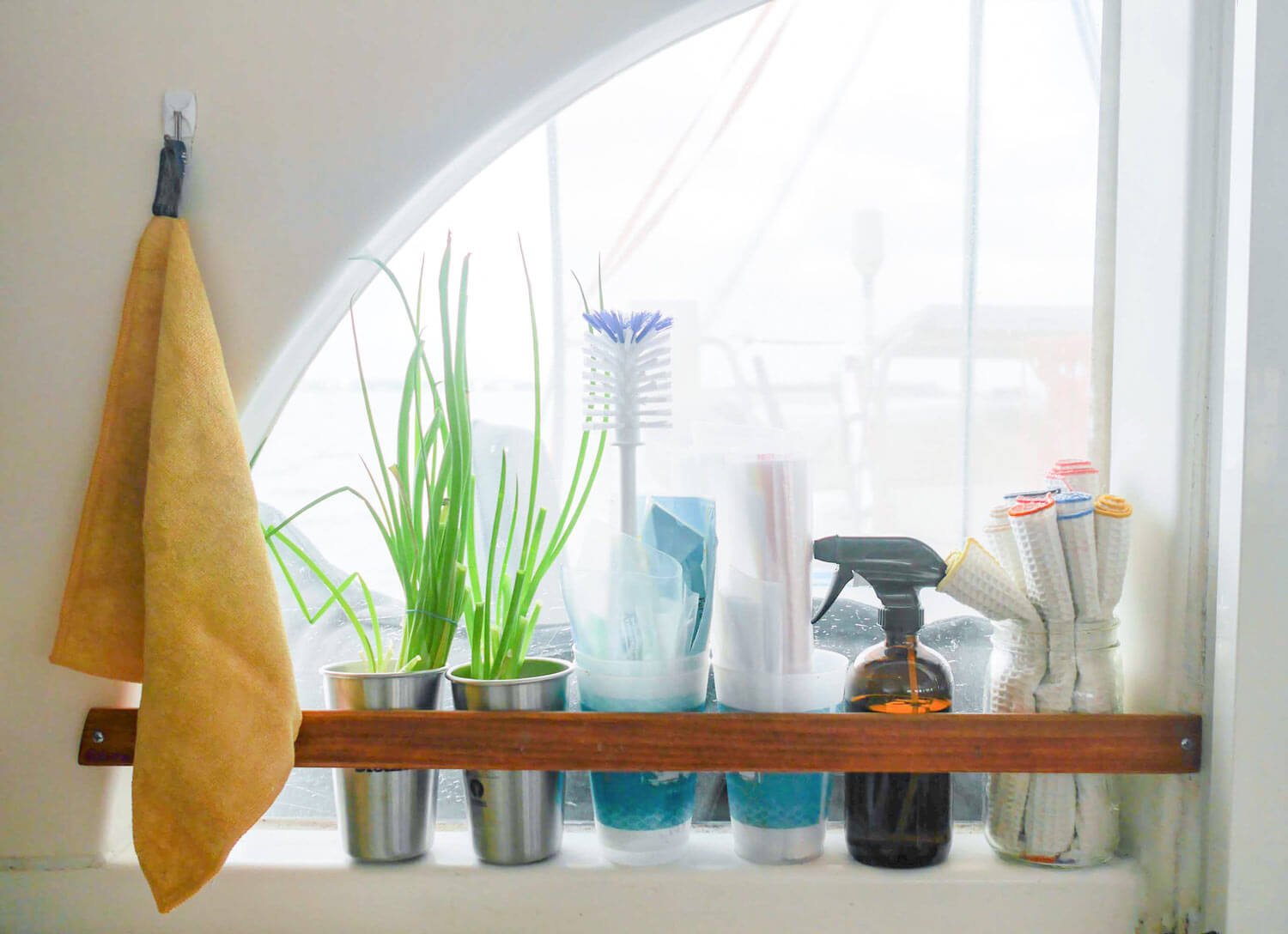
Our boat has an aftermarket addition (it’s really just a piece of wood) to secure items in the galley’s window. It adds storage for plastic bags, reusable paper towels, cleaning supplies, and the perfect spot for regrowing green onions.
This addition keeps items accessible and in place when we’re underway.
2. How to Utilize Clothing Storage
Keeping clothes free of mold and mildew is always a concern for boaters. The more layers you can put between your clothes and the boat, the better off you’ll be.
Clothing in a Wardrobe
To add two lines of defense to wardrobe clothing storage, use hanging storage shelves . Then use baskets to add another layer of protection and to keep clothes organized.
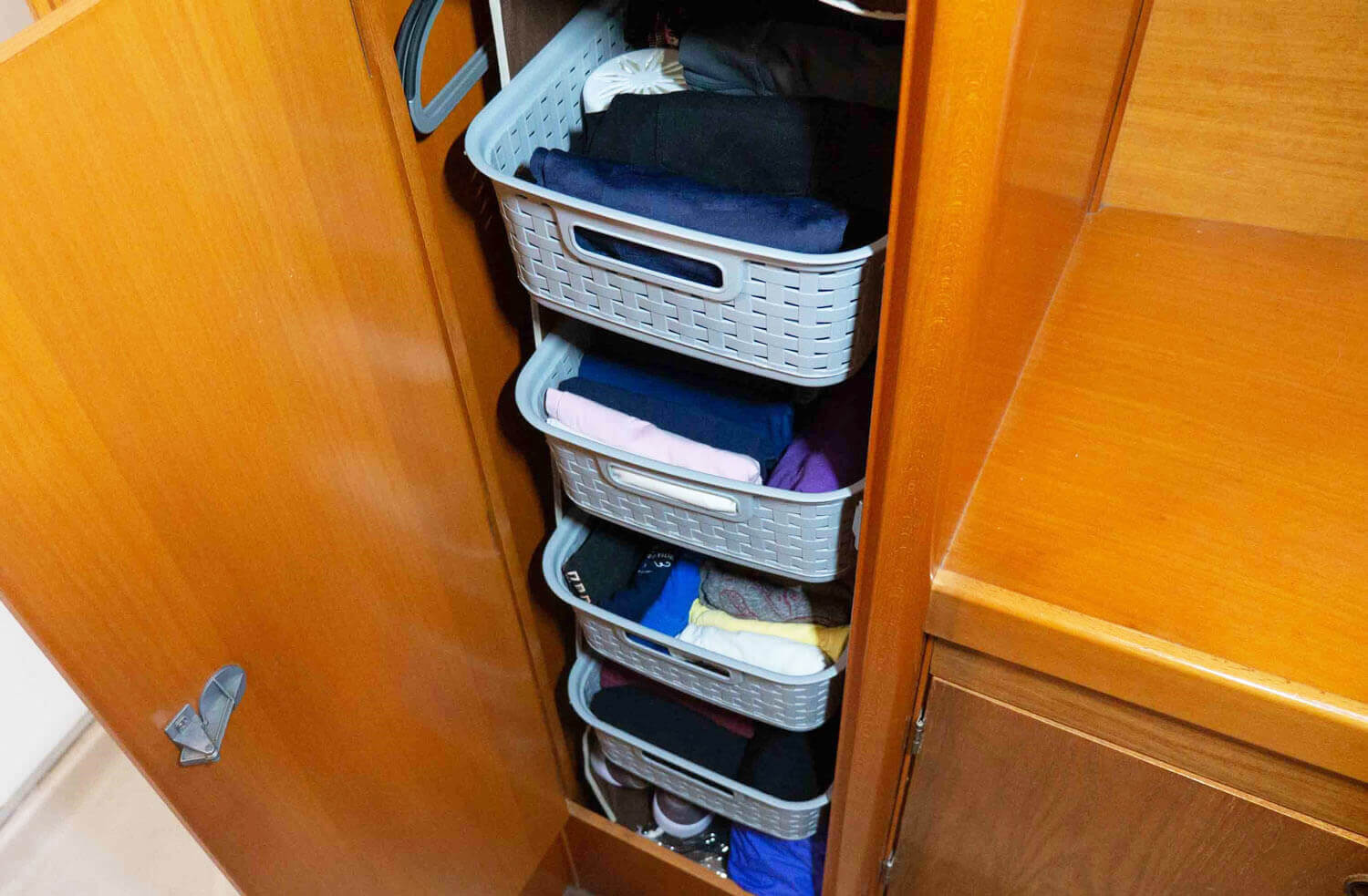
- Hanging shelves with side accessories pockets
- Hangs from two durable hooks
- 12" x 11.5" x 42" inches
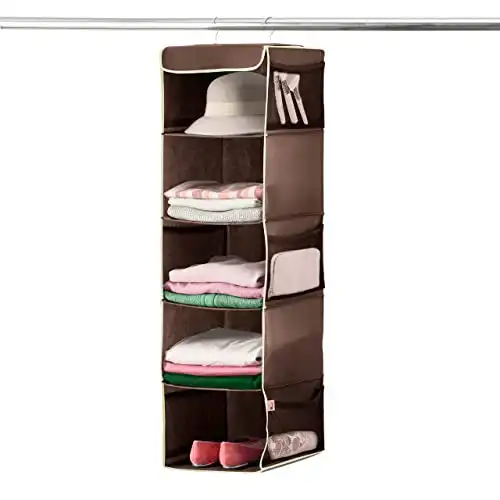
The baskets pull out so you can see what you have without creating a mess.
NOTE: Boats will often have wardrobes with a vertical bar. We punched holes in the top of the hanging shelves and rotated the hanger to hang vertically. Remember to measure the width and depth of your wardrobes to find the right size hanging shelves.
Clothing cabinet storage.
Shallow storage containers work well in cabinets for larger clothing. Clothing drawer organizers are ideal for underwear, socks, small t-shirts or tanks, and even bathing suits.
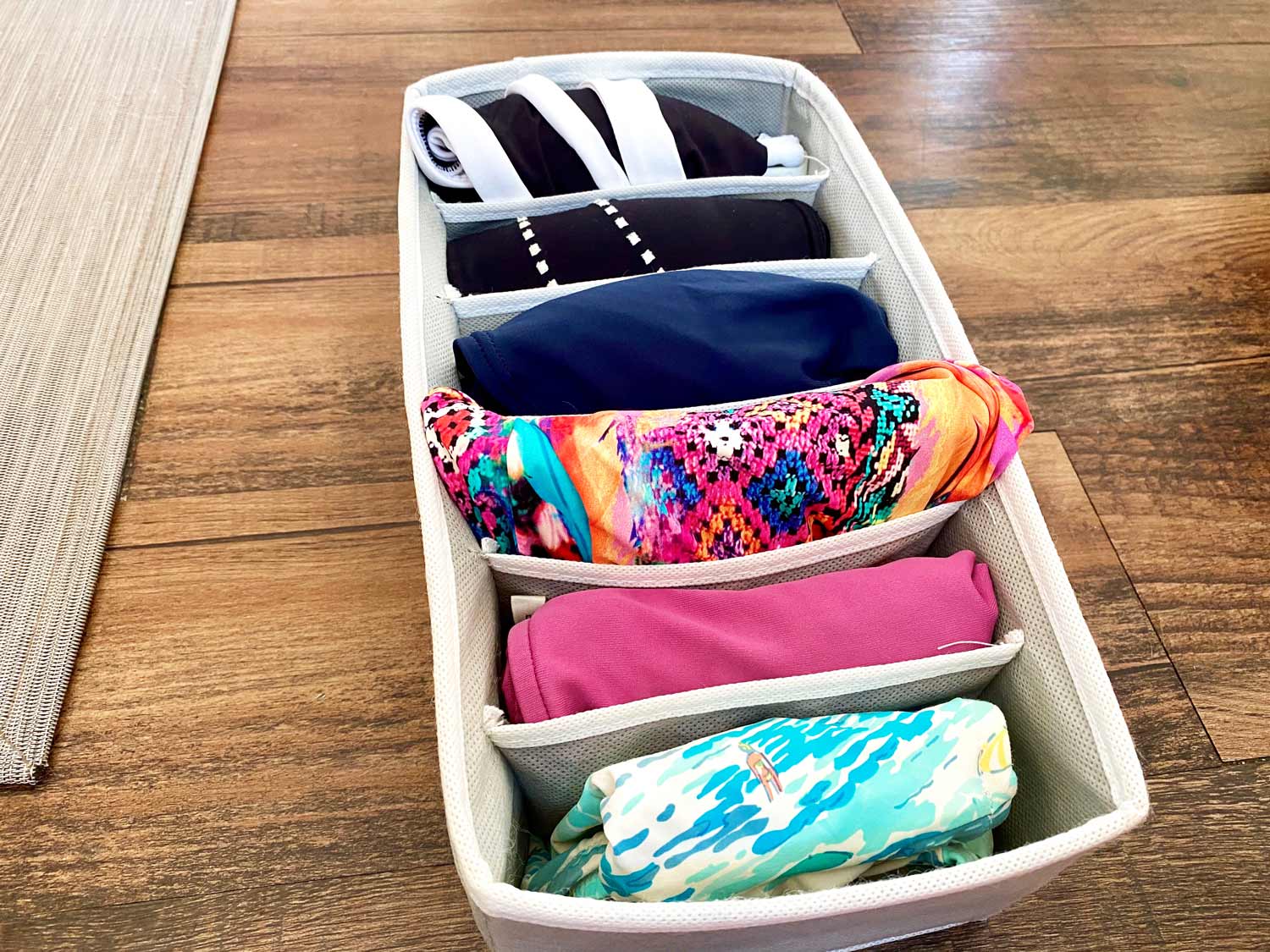
- Organize socks, underwear, small tanks and tees
- Includes four various bin sizes
- Collapsible
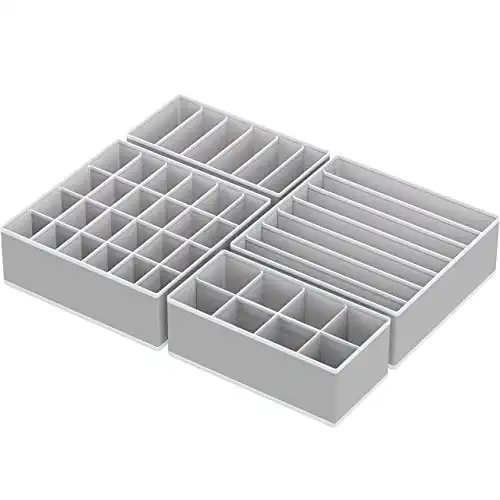
Containing your items neatly in a storage container is the best way to avoid the area becoming a mess.
Mold & Mildew Control
We use a variety of moisture control for our clothing wardrobes.
- DampRid hanging bags in the closet (be careful where and how you hang these so they don’t move around too much and get a hole underway
- Use DampRid refillable cups in cabinets where you can sandwich them between storage bins (may only be a good option for catamarans since the collected water can spill)
- Charcoal bags provide odor and moisture control (recharge in the sun once a month)
- Eva-Dry mini dehumidifiers are great for shelves (these have to be plugged into an outlet to “dry-out”)
- If you’ll using hanging shelves or fabric drawer organizers, spray with mold spray once every 3-4 months
3. Boat Galley Storage Solutions
The galley is one of the most crucial areas to have adequate storage. If you want to enjoy cooking on your boat, easily getting to your cooking tools and ingredients is essential.
Here are a few of our favorite ideas for storage in the galley.
Storing Ingredients in Baskets
These baskets have been a constant on the boat and during our RV days. The handles allow you to easily pull the baskets out of a tight space to see the contents. You’ll find things in your fridge and tiny cabinets with little effort.
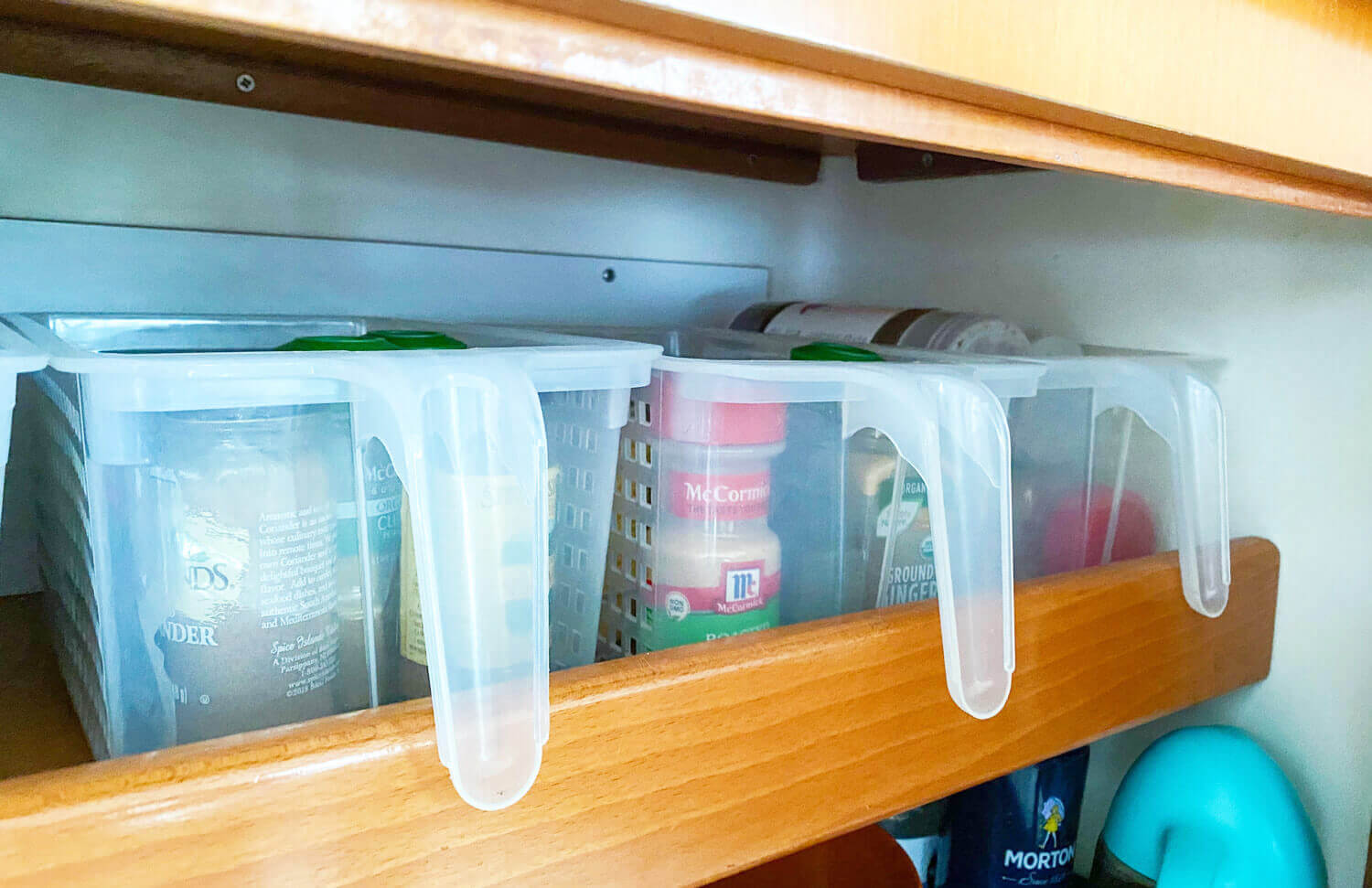
Maximizing space while being able to see what you have is vital in a small boat galley.
READ NEXT: You might also want to check out our sailboat galley essentials list .
Storing small amounts in easy reach.
One of our favorite tricks is having a small container of dry goods within easy reach.
We use 6 oz. containers for things like cornstarch, baking soda, and baking powder. We use a larger air-tight container for things like flour. We store the bigger box or bag securely under our settee and then refill it when needed.
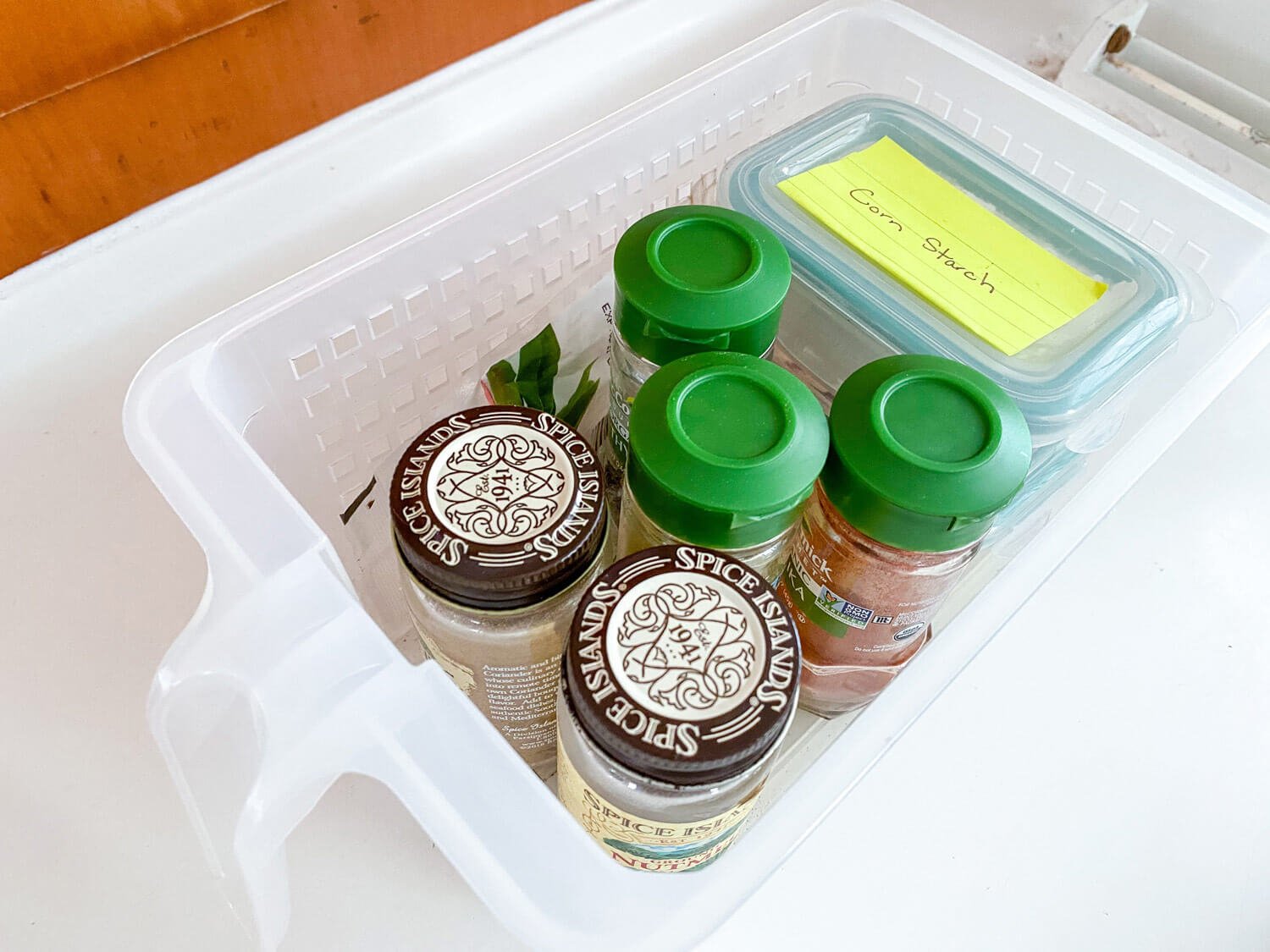
- Set of three storage baskets with handles
- Keep cabinets, cupboards, and the fridge neat and tidy
- Size small, medium, and large in a set
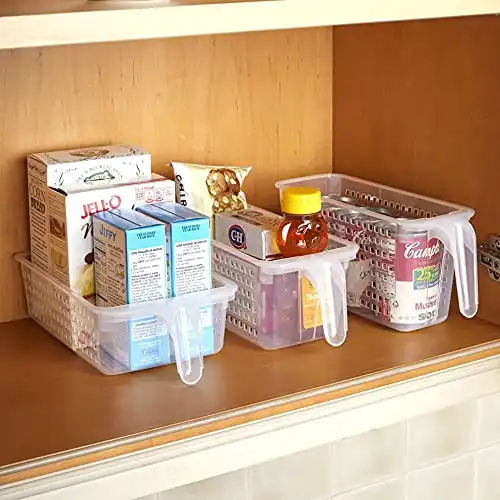
This method keeps bulk storage fresher and makes baking muffins or making pizza dough much more efficient. Not having to go for a deep dive to retrieve the larger store-bought package of dry goods saves time and effort.
Hanging Galley Tools
Using Command strips to hang things in easy reach is a helpful storage idea for living in a small space.
One of our favorite ways to utilize command strips and other hooks is inside cabinets. Hanging kitchen tools such as spatulas, cutting boards, oven mitts, and the cheese grater makes accessing tools for cooking on a boat much more effortless.
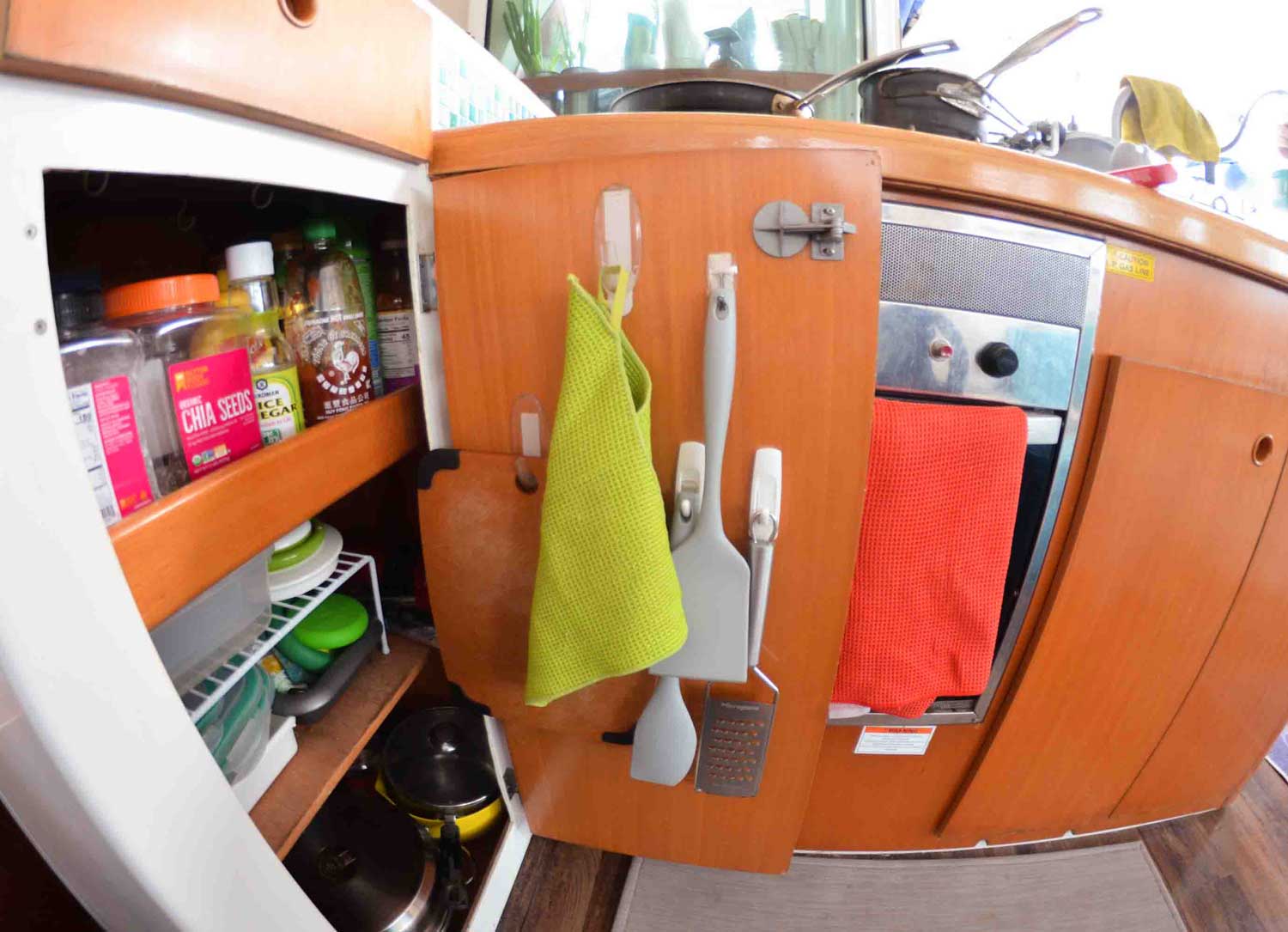
Placing a Command hook in a convenient location to hang your cleaning rag or dish towels is an excellent way to give it a home where it can dry.
Command’s line of hooks is full of variety. See all sizes and colors here .
4. Ideal Long-Term Storage
Storing things more long-term on a boat requires a different approach than items you use every day. Here are a couple of ways we store seasonal or rarely used items.
Vacuum Storage Bags
Vacuum bags are a favorite long-term storage option among cruisers. Even if you don’t deflate the bags, they protect items from water and mold. Use them in the bottom of cabinets, under berths, and any storage area that isn’t opened often. When in doubt – bag it!
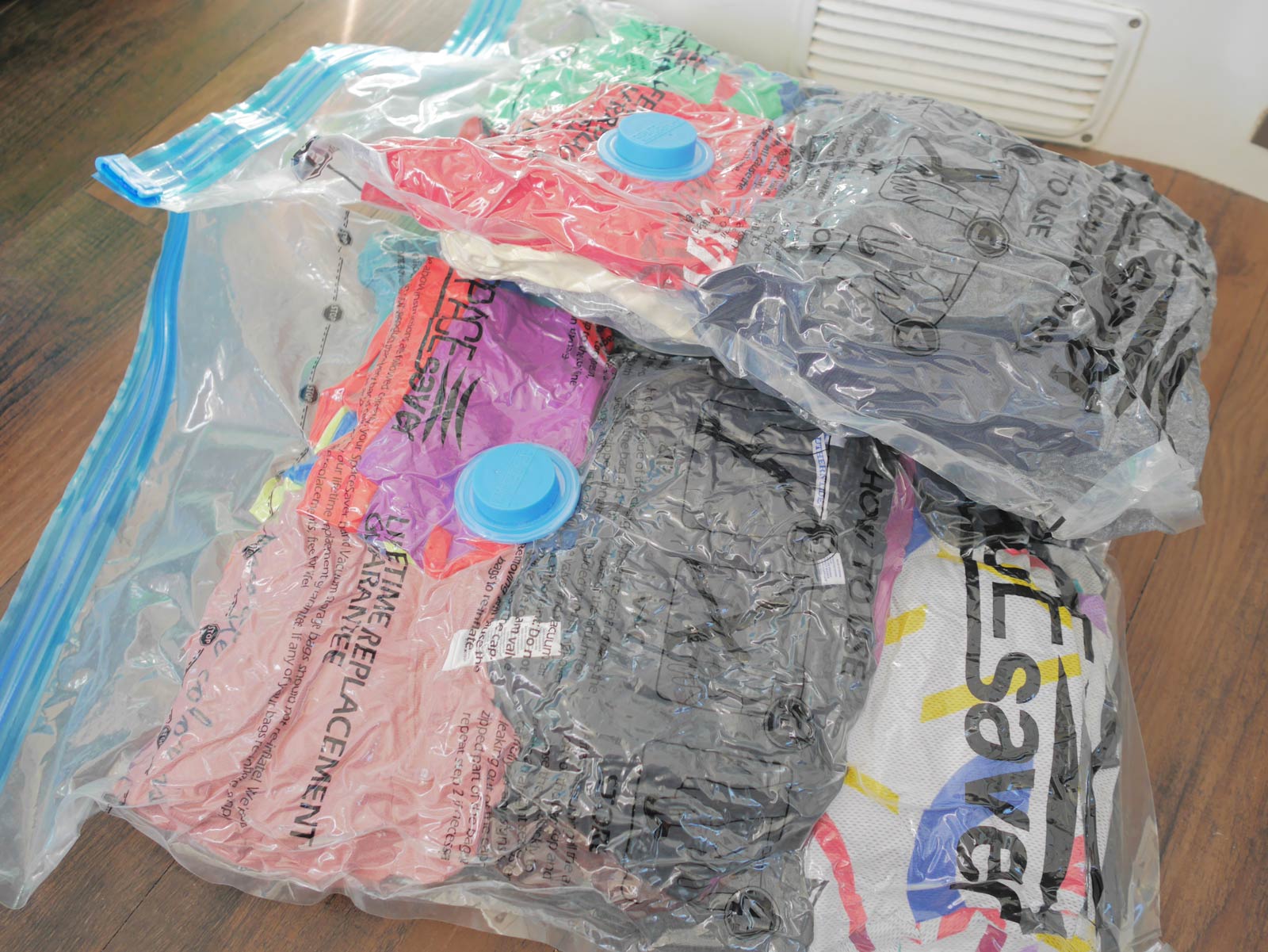
- Creates 80% more storage
- Double-zip seal and triple seal valve Vacuum
- Small size is great for clothing and small towels, medium and large sizes are great for comforters, blankets, and bedding
- Includes hand-pump
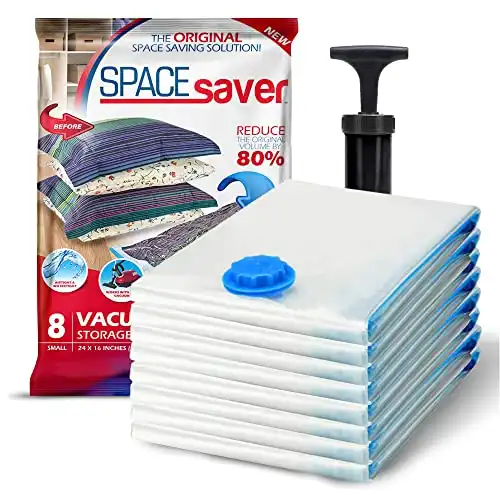
Jumbo Size Vacuum Bags
The jumbo bags are perfect for storing luggage bags and backpacks. We even use them to protect the cats’ soft carriers and scratching boards.
How to Store the Bags Onboard
For extra clothes and bedding, you can remove the air and store the bags under a berth inside a Rubbermaid tub. The tub makes it easier to stack the bags and keeps them from sliding around and risking a puncture.
NOTE: Using vacuum seal bags can be a little tricky without a standard vacuum cleaner. We use our handheld Dyson with the attachment removed to suck out most of the air. Then, finish with the hand pump attachment included with the SpaceSaver bags above.
Collapsible storage bins.
Small and large – these Scout brand bins are great for storing extra kitchen gear, food, tools, and more.
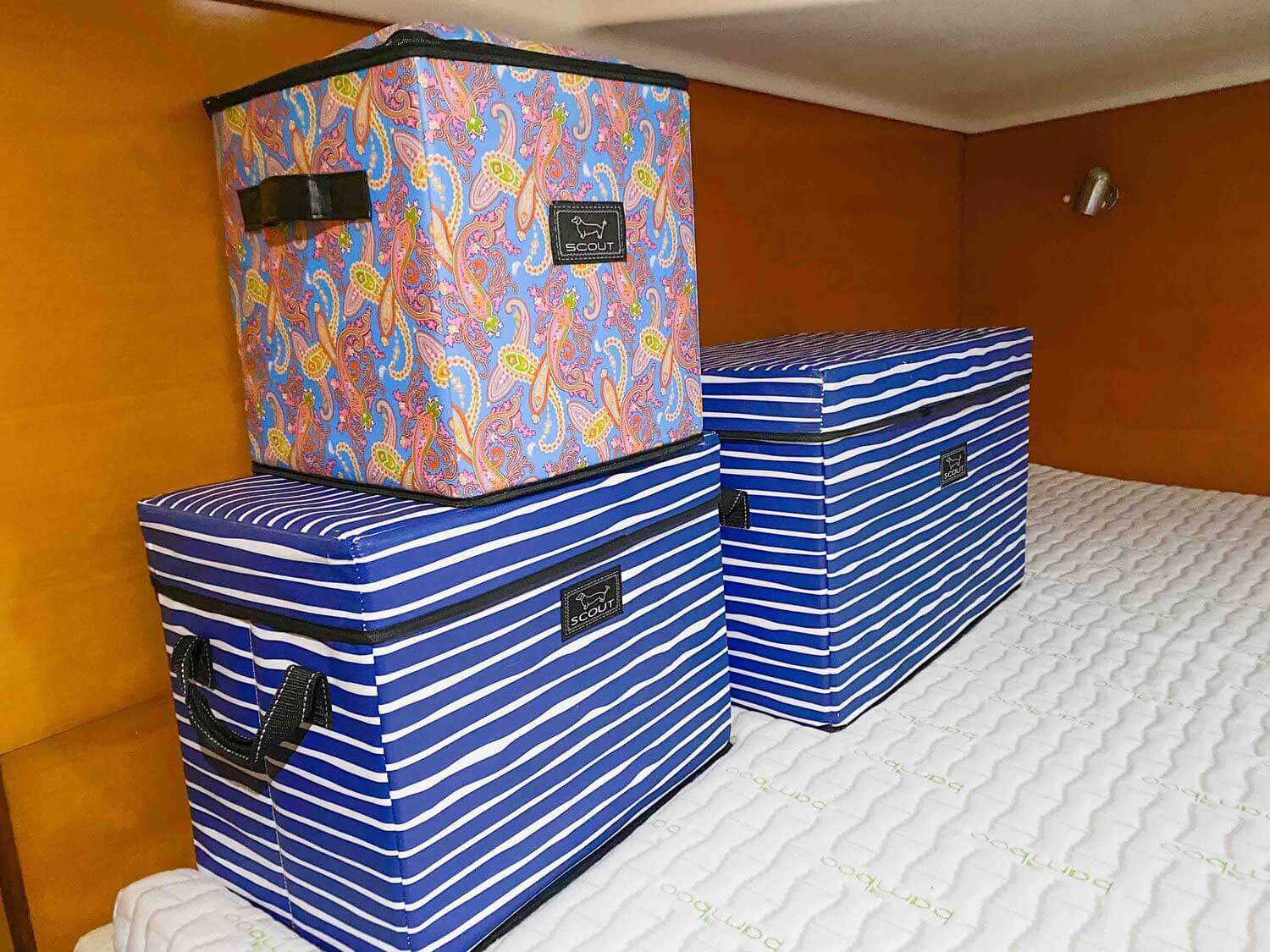
- Medium size, lidded storage bin
- Bin and lid are collapsible
- Bin is stackable
- Holds 80lbs
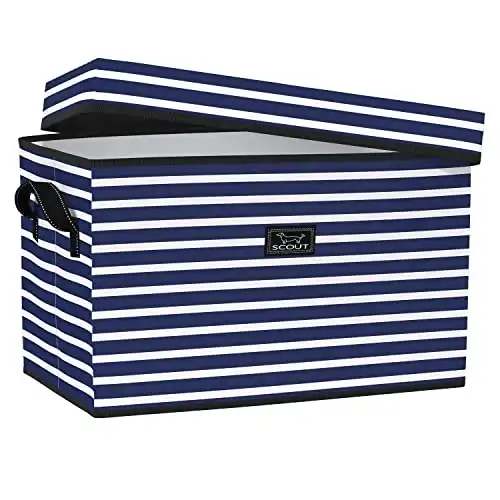
- Large size, lidded storage bin
- Holds 90lbs
Storage Bin Features
Check out Scout’s website for all storage bin sizes and patterns .
READ NEXT: These storage bins also made our list of 10 Essentials for Life on a Sailboat .
5. taming outside locker storage.
Outside locker storage can be tricky. It’s often more exposed to the elements – water, dirt, and temperature. Crash lockers and larger lockers can also be tough to get in and out of. Here are a few tricks we use to keep them organized.
5-Gallon Buckets
Do not underestimate this simple storage item. We love our 5-gallon buckets for many reasons, but they also double as storage. In our outside storage, the watertight lids keep the bucket contents dry.
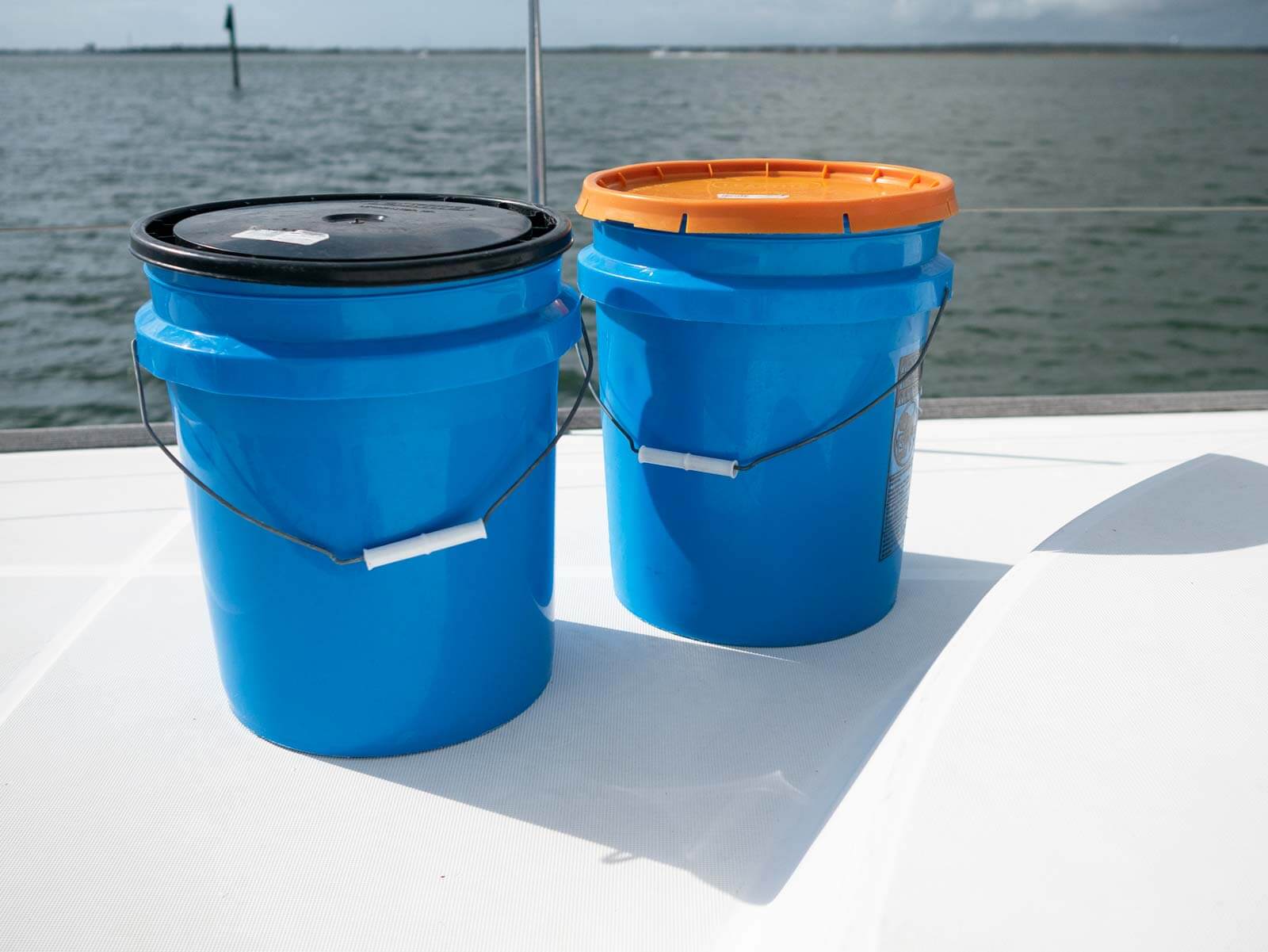
Since they have handles, they are easily moved around and can be fetched with a boat hook in crash lockers.
In our cockpit storage, they make use of horizontal space while keeping everything organized. It’s also easy to remove the buckets when the storage space needs cleaning.
TIP: Keep a list of what’s stored in each bucket. Create different color combinations with the buckets and lids to tell them apart.
You can pick up 5-gallon buckets with lids at Walmart or Home Depot for a very reasonable price.
Straps for Power Cord and Hose Storage
These durable straps with handles make storing hoses and power cords a breeze. They allow you to get a handle on the mess and tangles that occur.
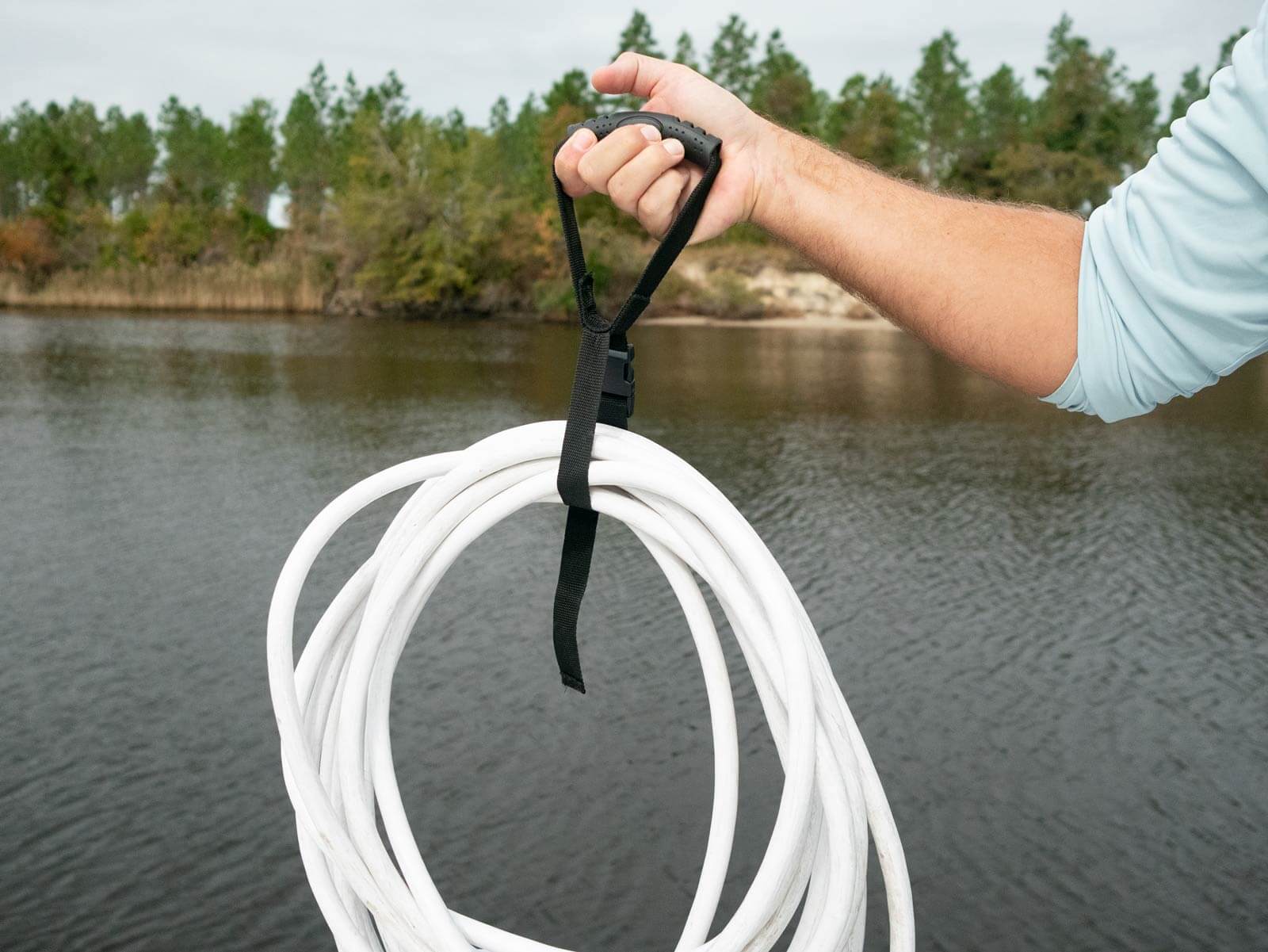
- Camco storage straps with carrying handles
- Neatly stores electrical cords and hoses
- Makes toting and hanging easier
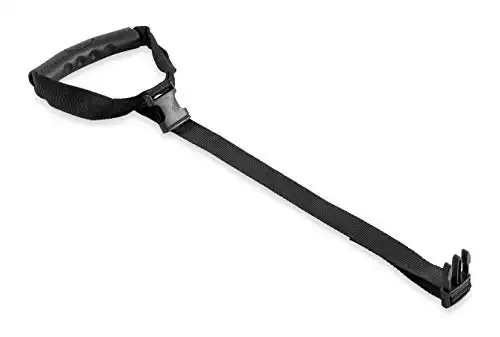
It’s easy to lower them into the front crash lockers and then fish them out with the boat hook when you need them. For us, this opened up more storage in the easy-to-access lockers in the cockpit.
6. Best Collapsible Items
When it makes sense, opt for a collapsible item. In the galley, it might be a collapsible colander, mixing bowls, or measuring cups. Here are some other collapsible items that are practical on a boat.
- A small collapsible stool is instrumental for many projects. Ideal for when you need a seat to work in an area or reach something a foot higher. When flat, store it in a locker.
- Collapsible tubs are helpful for many projects and daily chores. Essential for conserving water for washing dishes, washing clothing, or kitchen towels. The tub below is the right size for most tasks and fits in the sink. We have one for dirtier jobs and one for laundry.
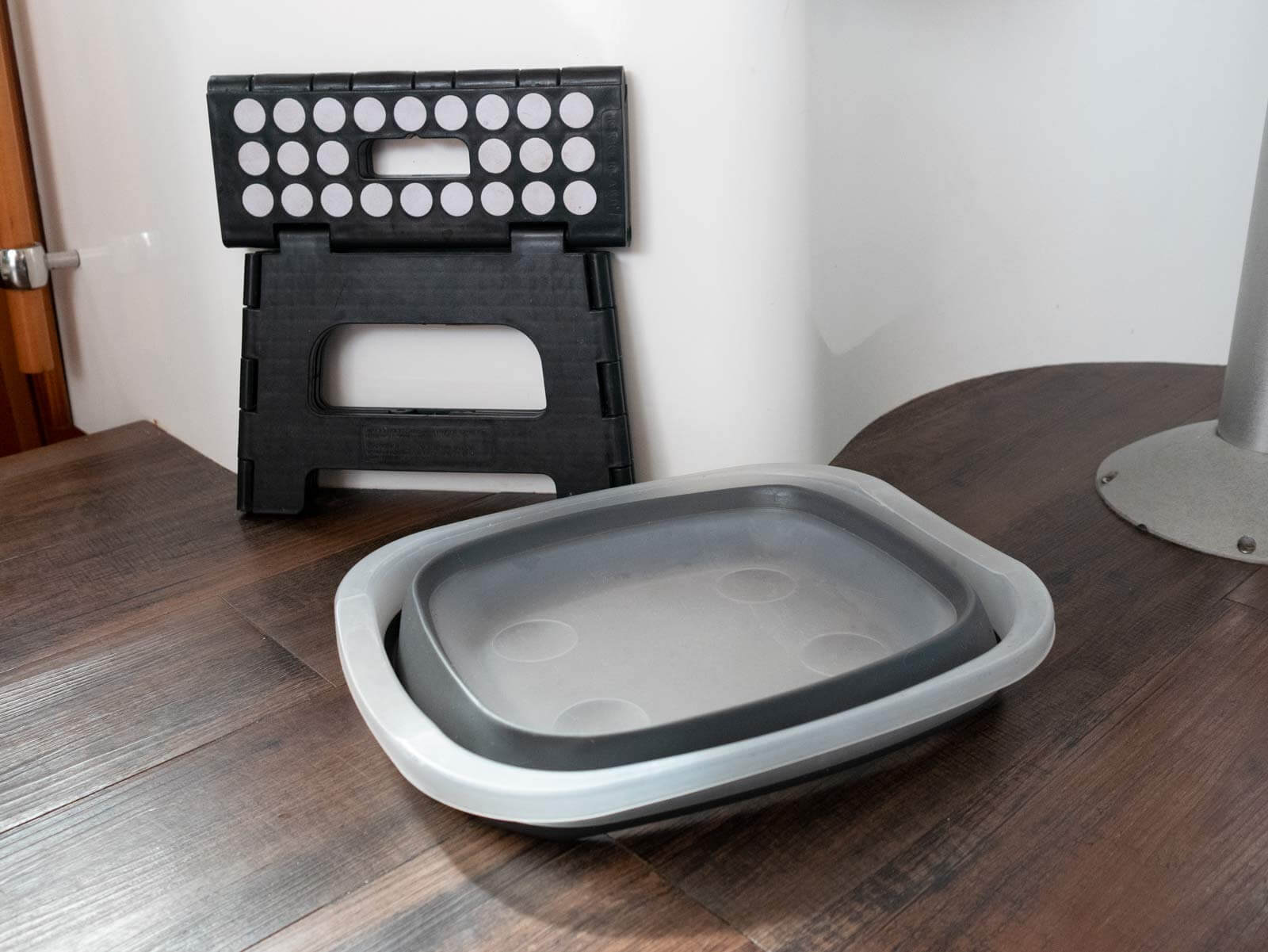
You can also find collapsible dish drying racks (or tubs), as well as larger buckets and bins for washing or carrying laundry. We love this durable collapsible laundry bag .
Best Way to Store Items on Your Boat
Every boat is a little different. Certain things that work great on one boat might not work well on others. So get creative with your storage options!
Your most effective method to fight storage woes is to be selective about the items you bring on the boat. Revisit all storage spaces seasonally and get rid of things you aren’t using or that aren’t serving a purpose.
Want more lists of boat gear for your liveaboard life?
View our guide for lists of essential sailboat gear, galley must-haves, what to wear sailing, and more.
Like this post? Save it on Pinterest for later.
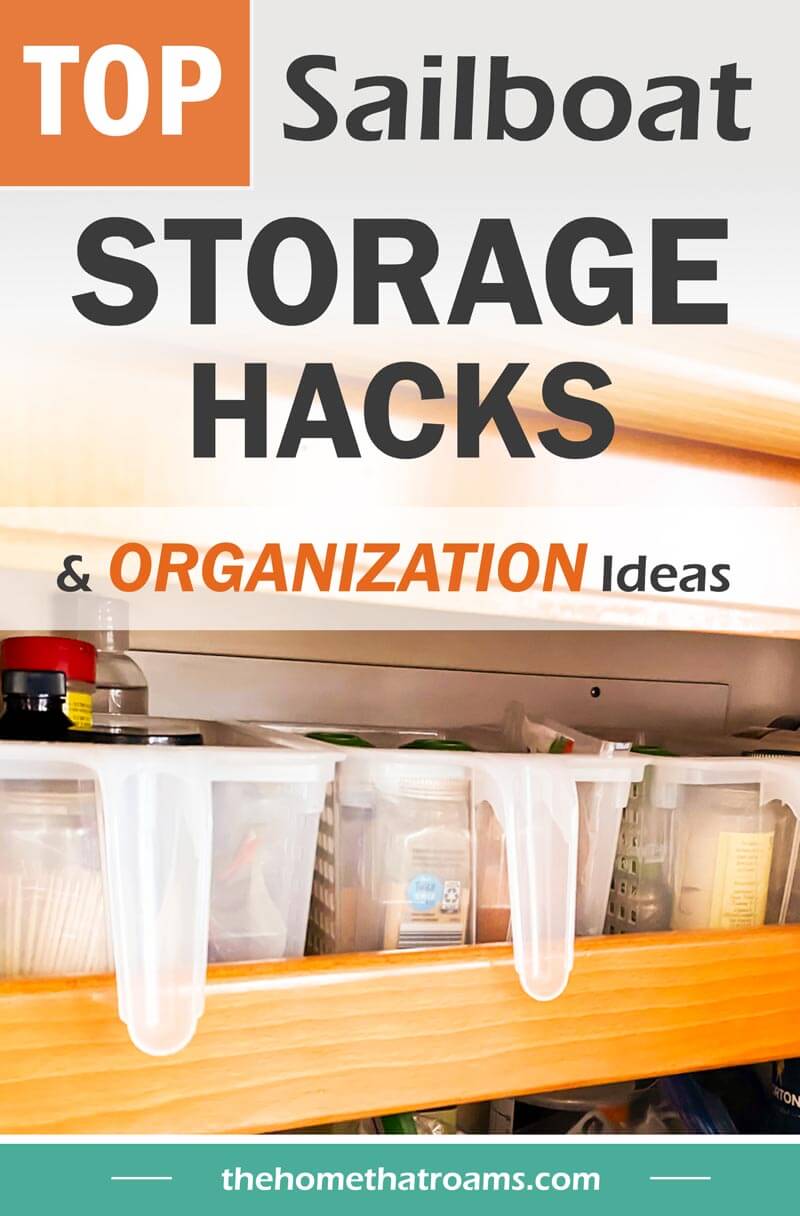
Morgan, the founder of The Home That Roams, has been living nomadically for over five years. She began her journey traveling across the U.S. in a motorhome and cruising on a liveaboard sailing catamaran. Currently, she lives full-time in a travel trailer, sharing resources on RV living and boat life to help others downsize their lives and thrive in an alternative lifestyle.
New Sailor Here. These tips are so helpful! Thank you for sharing!
Hey Meghan, glad you found some good tips! Happy sailing 🙂
Leave a Reply Cancel reply
Your email address will not be published. Required fields are marked *
Sign Me Up!
Learn how to live on a boat.
Get weekly tips on how to start traveling full-time on a boat.
View our privacy policy .
Privacy Overview


IMAGES
VIDEO
COMMENTS
In this video we show you 10 BOAT HACKS that make our life aboard much easier. They are our TOP BOAT ESSENTIAL ITENS. After experimenting different accessori...
Boat life is not always easy so finding hacks, shortcuts, systems that work is essential. Over the past 9 months, we have found these 12 boat hacks/purchases...
However, these essential galley items will make sailboat liveaboard life much easier and more delicious. ... And with limited space and sometime limited energy sources, it's a good idea to learn some of these essential galley liveaboard hacks. These are my favorite galley items that will help make your onboard cooking experiences easier and ...
We have lived in our sailboat for over 8 years now. Here are some simple but very useful "life hacks" that we have discovered along the way that make living ...
They resort to schlepping buckets of saltwater down to the galley to pre-rinse their dishes, or they lug the dishes to the transom to do the same. We just use the saltwater foot pump at the sink, then wash and final rinse with fresh water. 2. Freshwater foot pump (or hand pump) in the galley and head sinks.
Setting the Anchor: Drop the anchor, release enough rode, and slowly reverse the boat to firmly set the anchor in the seabed. Give it a strong tug to confirm that it is securely in place. 6. Docking: Practicing docking skills is essential to safely maneuver your boat into a slip or alongside a dock.
Hacks May/June 2019 Issue Boat Hacks DIY liveaboard lifestyle. By. Becca Guillote. Becca Guillote is an adventurer, writer and entrepreneur who cruises with her husband, John, aboard their 1976 Valiant 40. The couple have extensively traveled the Inside Passage, Mexico and Central America, and recently added a Pacific Ocean crossing to their ...
What is your favorite liveaboard hacks? We're especially interested in those focused towards sail boats. And if these hacks are for increasing organization -- double star! Thanks in advance for responding! 12-07-2018, 17:51 #2: JPA Cate. Moderator . Join Date: Nov 2011.
Yes, many people live aboard sailboats. It's legal in most places, and there's a relatively large online community dedicated to the practice. The majority of people who live on sailboats do it because they love sailing and the lifestyle. Liveaboard Sailboat Utilities. Like a house, your sailboat needs utilities if you plan to live aboard.
Here's a few of our hacks that come to mind after 24 years of live-aboard cruising: Clothes storage hack: Store your neatly folded clothing in vacuum bags like those found a WalMart, etc. Stuff half of a dryer sheet in each one. Your clothes will stay dry and mildew free and will smell like they just came out of the dryer when you take them out of the bag.
One philosophy in getting started living aboard a sailboat is to start small, start now. That doesn't mean you have to buy a major refit project of a sailboat. You can get started in a small 24 foot single cabin boat for less than $10,000 or a mid-size 36 foot sailboat (see video below) for less than $60,000. Or grab a 1980s fixer upper that ...
Check out Part 2: https://youtu.be/20JTyDwDdwUMaddie and Herby demonstrate small things that make a BIG difference for them as both liveaboards and cruisers....
Watching the sunset every day is one of the best things about sailboat living. Then there's the sunrises and sunsets, and the endless starlit skies. The thunderstorms that you're suddenly a part of, when before you could hide inside brick walls. The constantly changing sea and sky, and the sun and wind.
Life as a live aboard is its own reward. Written by: Heather Francis. Heather Francis is from Nova Scotia, Canada. She has worked and lived on boats throughout the world since 2002. In 2008 she and her Aussie partner, Steve, bought Kate, their Newport 41, in California and have been sailing her fulltime since.
9. Potted Herbs. 10. Magma Nesting Pots. Finding Your Sailboat Essentials. 1. Stainless Steel Clothespins. BBL (before boat life) in my Colorado condo, I did not need a clothespin and hadn't given one thought about them. Those were things my grandma used to dry laundry in the Stone Age.
Choosing a boat to live on is a big deal — something you definitely want to get right. There are plenty of options to pick from, which can make the choosing process a bit daunting. So to help you navigate those deep waters (no pun intended), here is an article summarizing the 13 best liveaboard sailboats under 30 and 50 feet.
Sample Liveaboard Budget. Now that we've covered the basic expenses to expect when living aboard, we'll put together a sample liveaboard budget. The figures are based on someone making a monthly income of $4,000 docking a 30-foot sailboat at a reasonably priced marina. Monthly Expense.
Sometimes it's the little things that make a BIG difference for life on board a cruising boat like Clarity. This week give you nineteen easy ideas that won't...
Initially the jib fills mostly and you think ok, lets secure the motor and breath a little easier. The motor quiets and the boat slows to a bare motion of 2 knots. The sun beats down on the boat and it's getting hot and a silence falls over the boat as the jib flaps uselessly in the still air. You should have kept the motor on.
Liveaboard sailboats that are cheap but actually good include Westsail 32, Alberg 30, Tayana 37, Catalina 30, Ericson 35, Albin Vega 27, Bristol 32, Morgan 323, Contessa 32, Pearson 365, Hunter 31, Cal 34, and Tartan 30. The prices of these boats range from $5,000 to $50,000 or more. Living aboard a sailboat on a budget doesn't mean you have to ...
Eva-Dry mini dehumidifiers are great for shelves (these have to be plugged into an outlet to "dry-out") If you'll using hanging shelves or fabric drawer organizers, spray with mold spray once every 3-4 months. 3. Boat Galley Storage Solutions. The galley is one of the most crucial areas to have adequate storage.
In this video, Liveaboard Life Hacks 2, we get right back into all new helpful tips and tricks for all cruisers. If you haven't seen our first liveaboard li...
On fishing trips, a clutter-free boat keeps things running smoothly. For proper organization, invest in a fishing rod holder. If you want to store more than just rods, try a tube unit, which stores fishing rods vertically and may have other storage holes for items like fillet knives and pliers. Shop Now. 7 / 9.